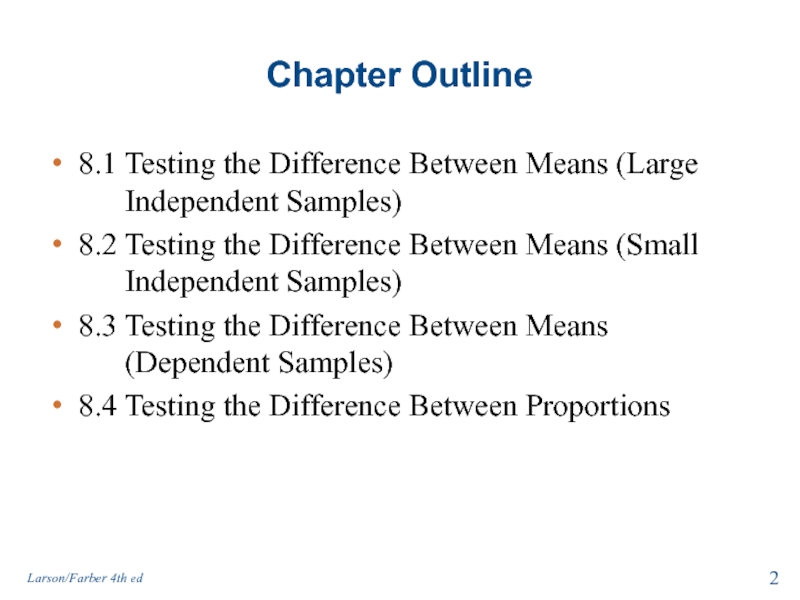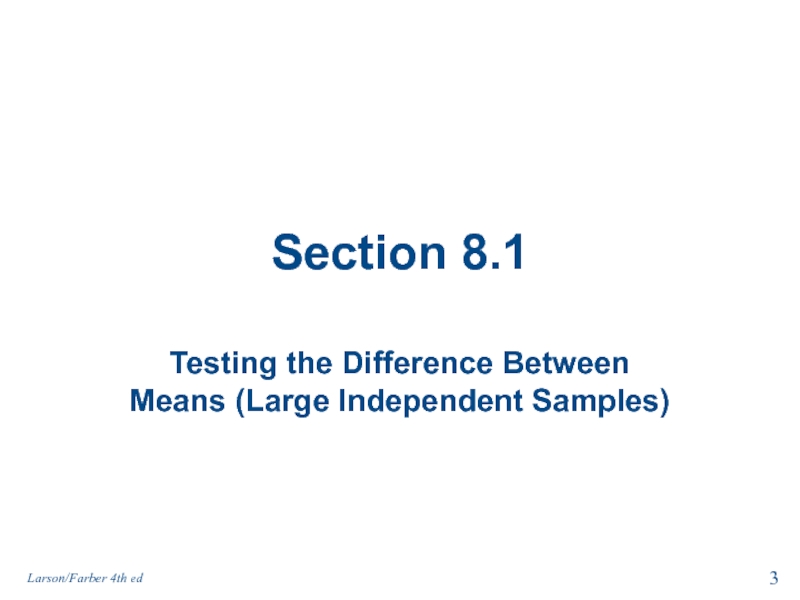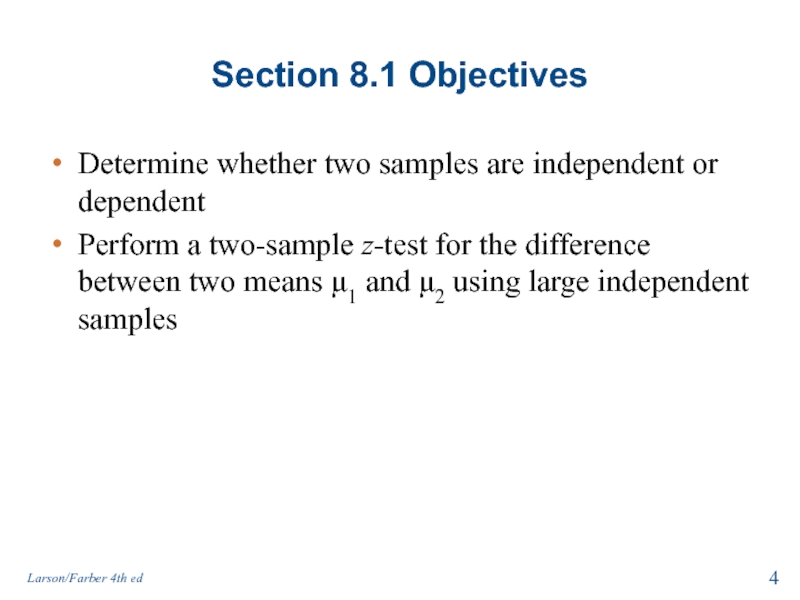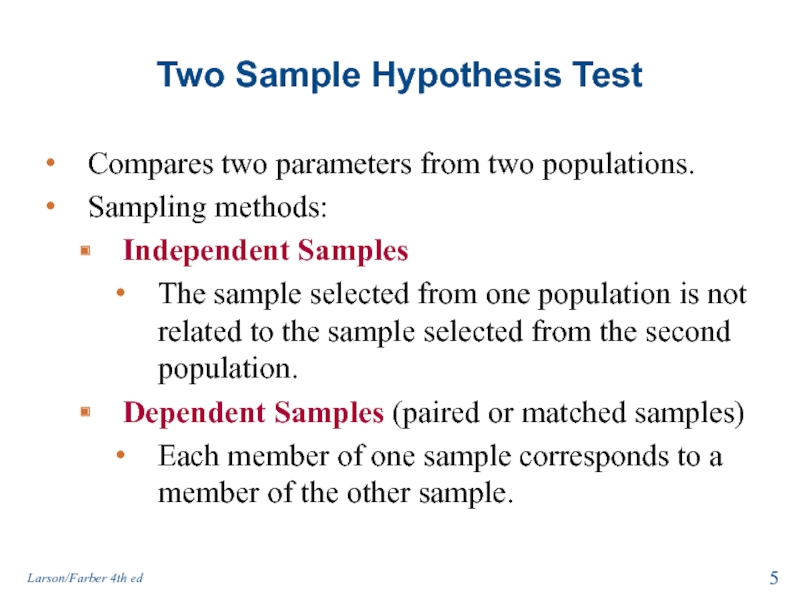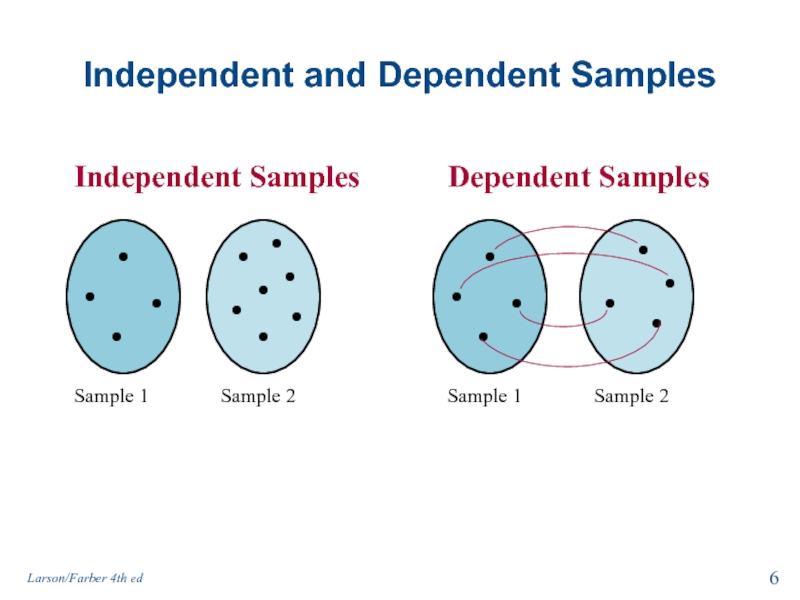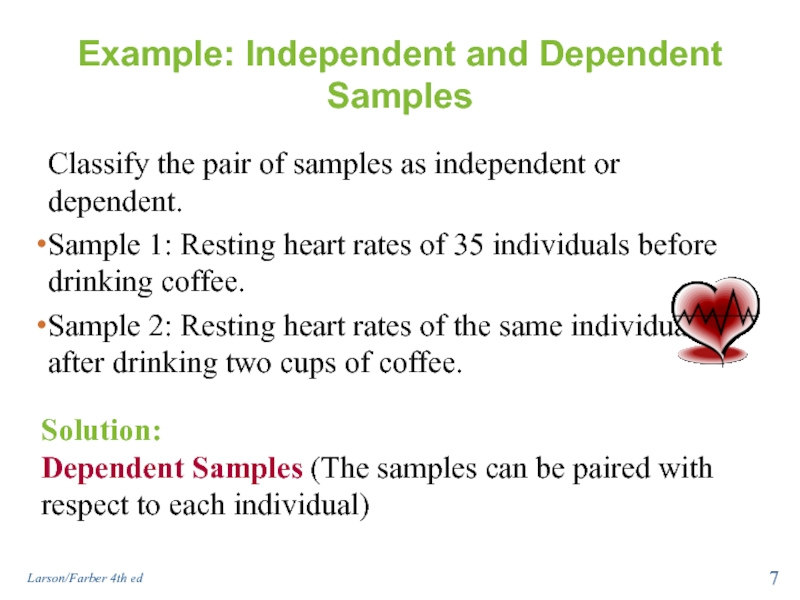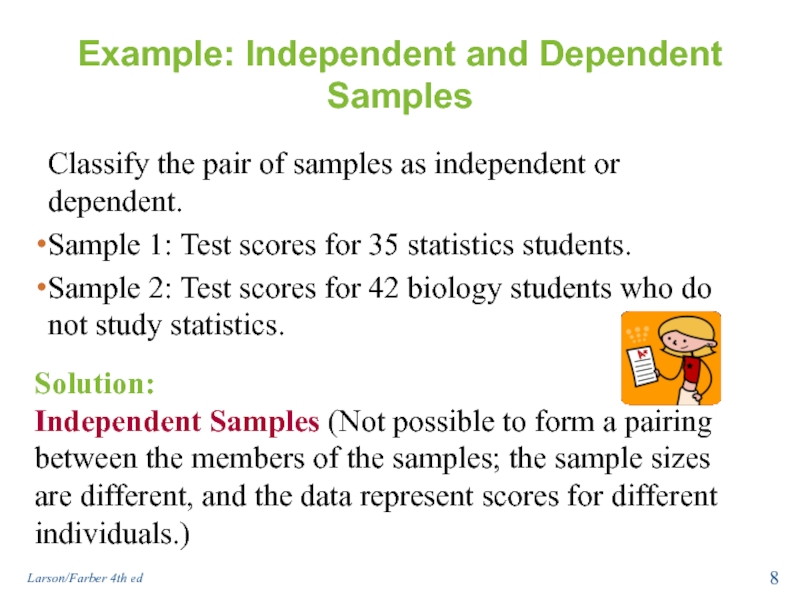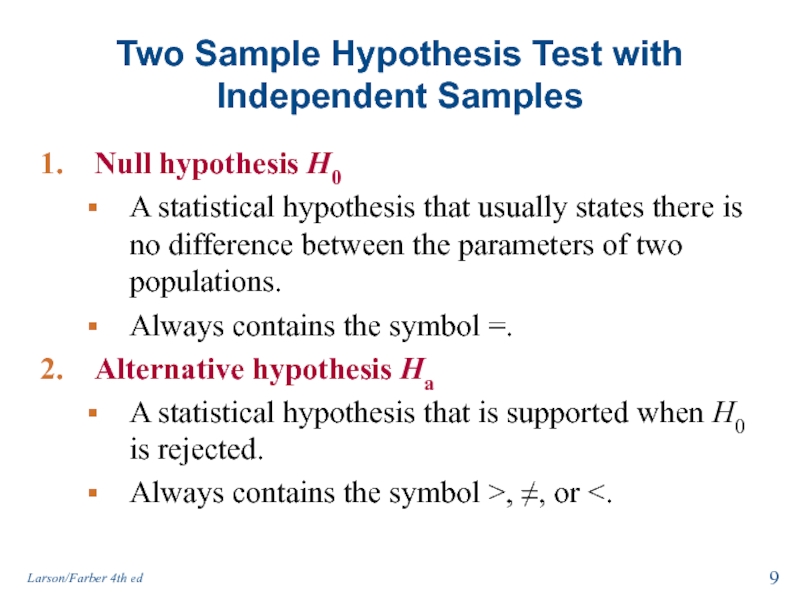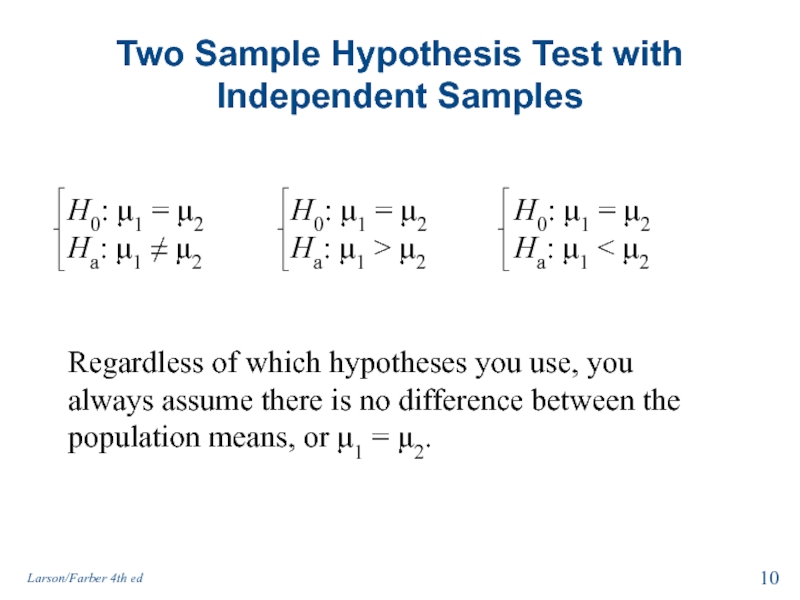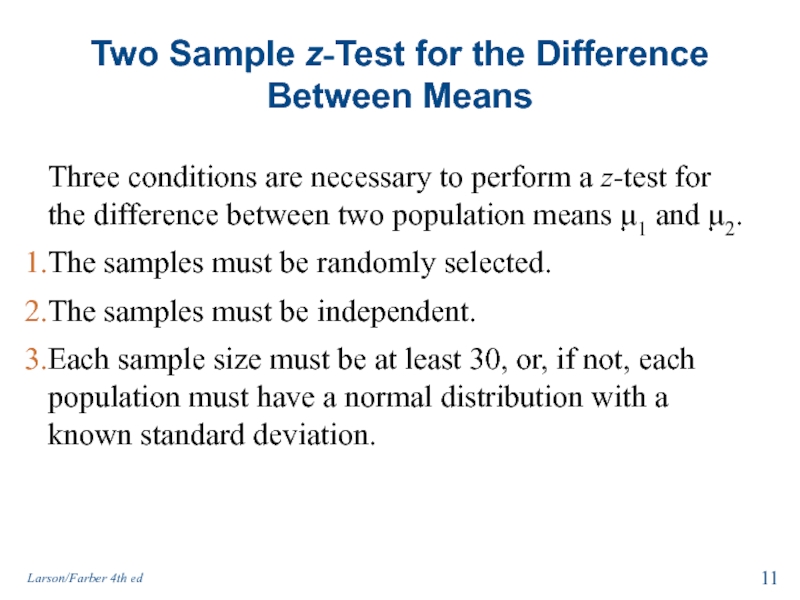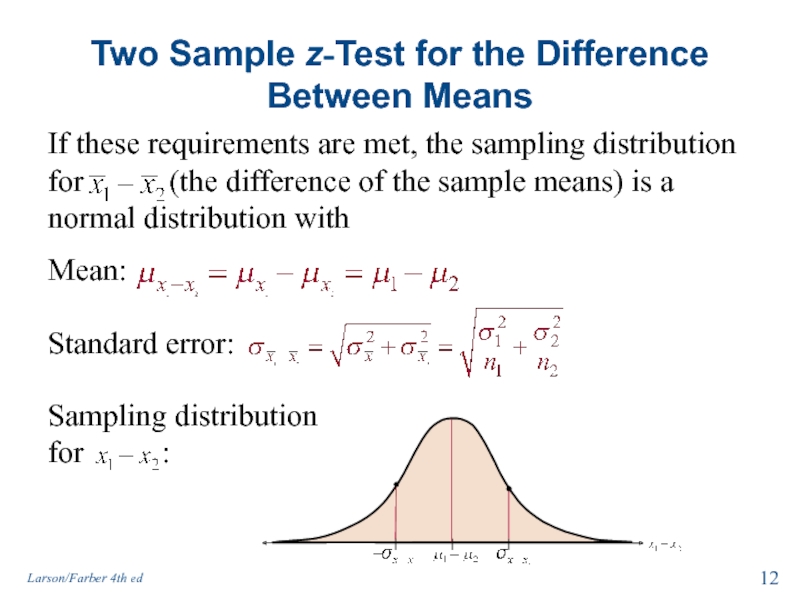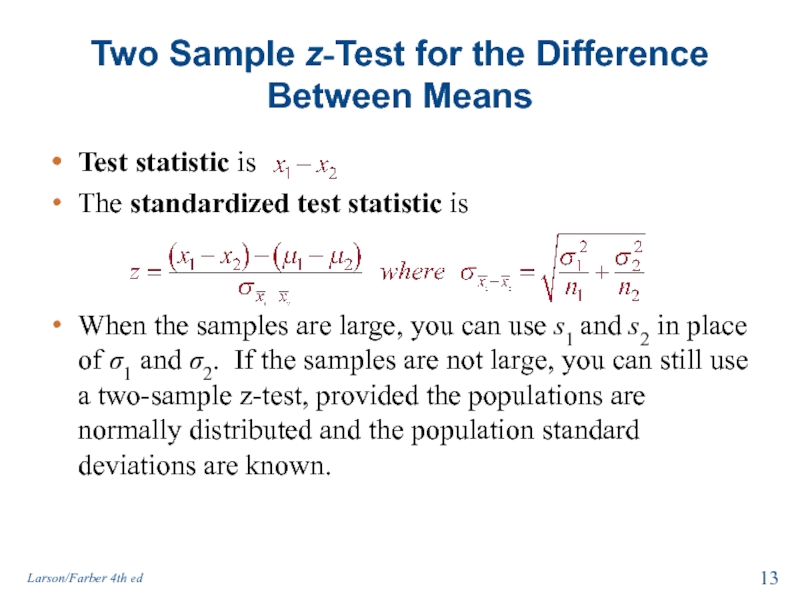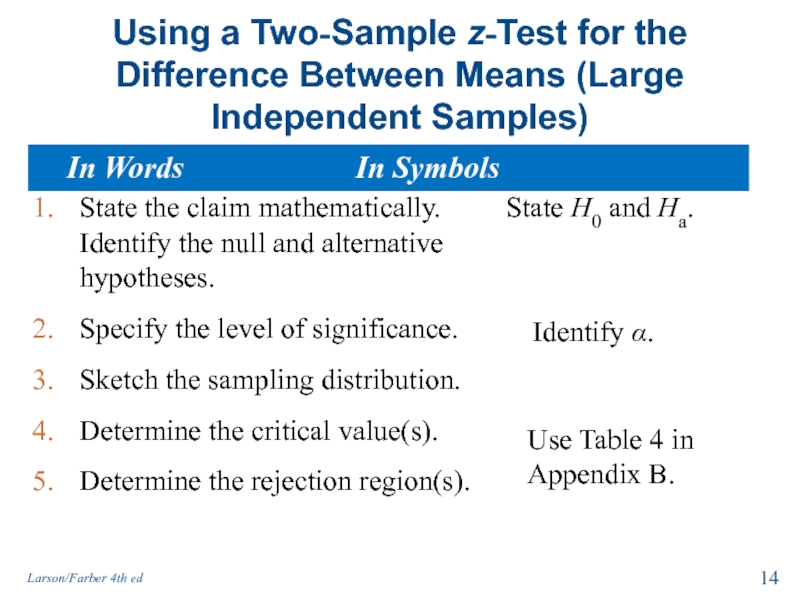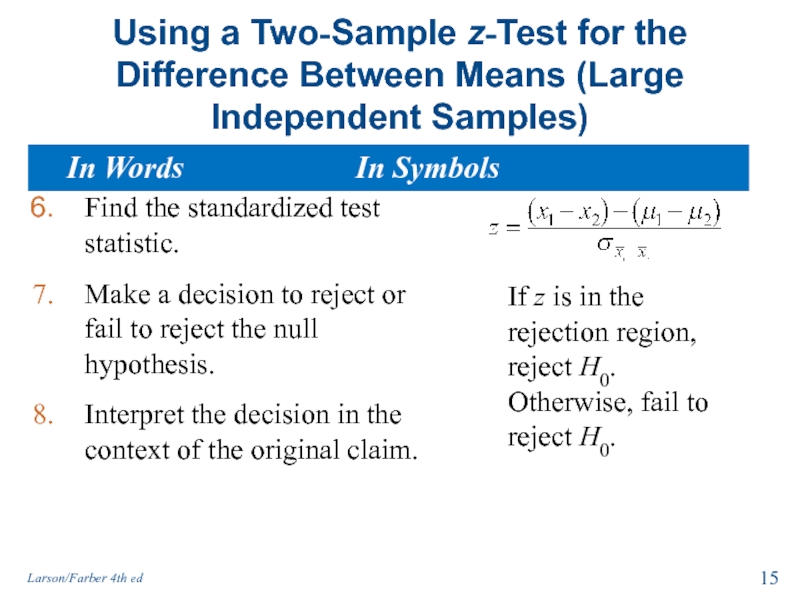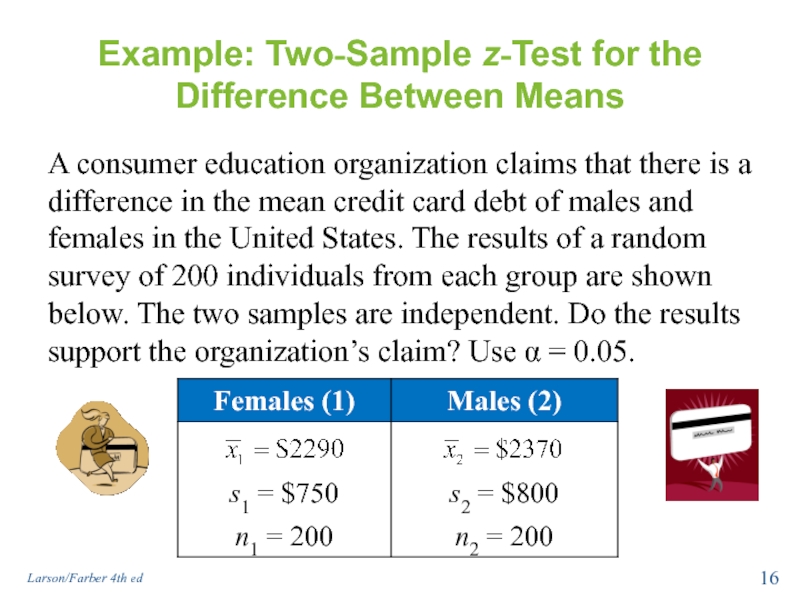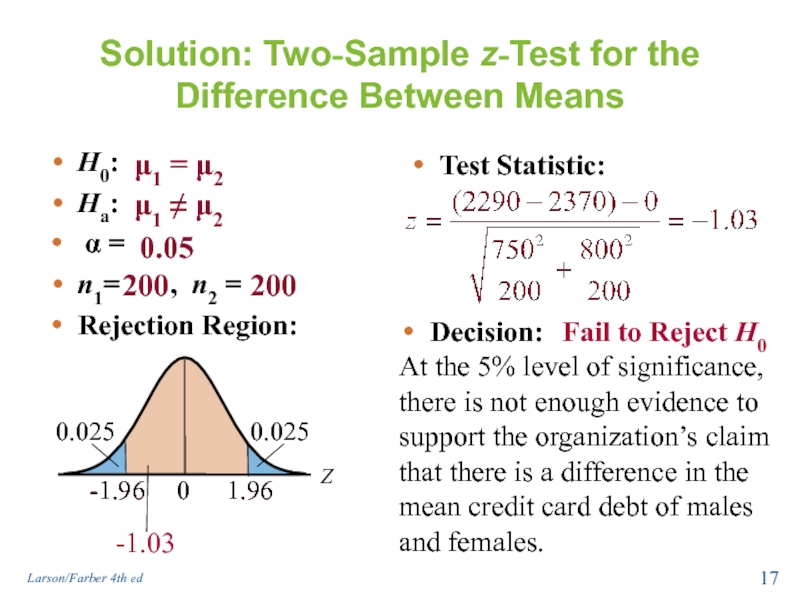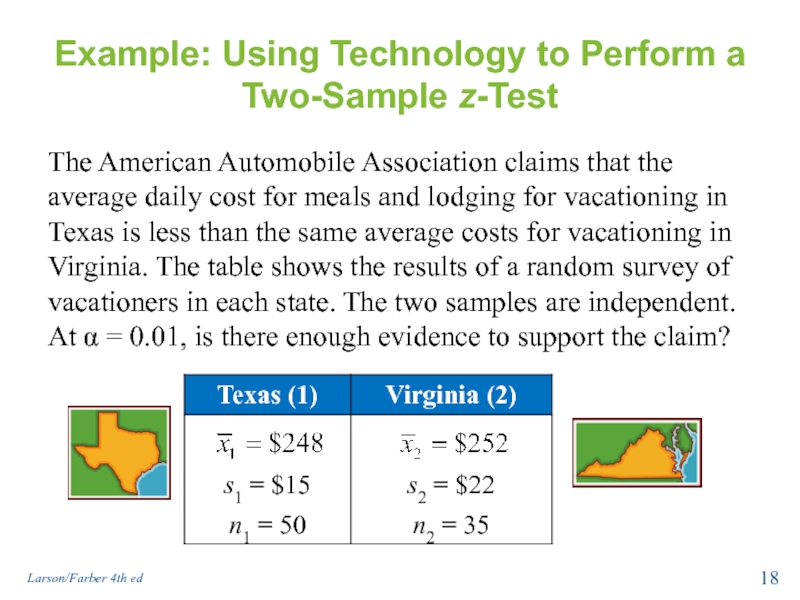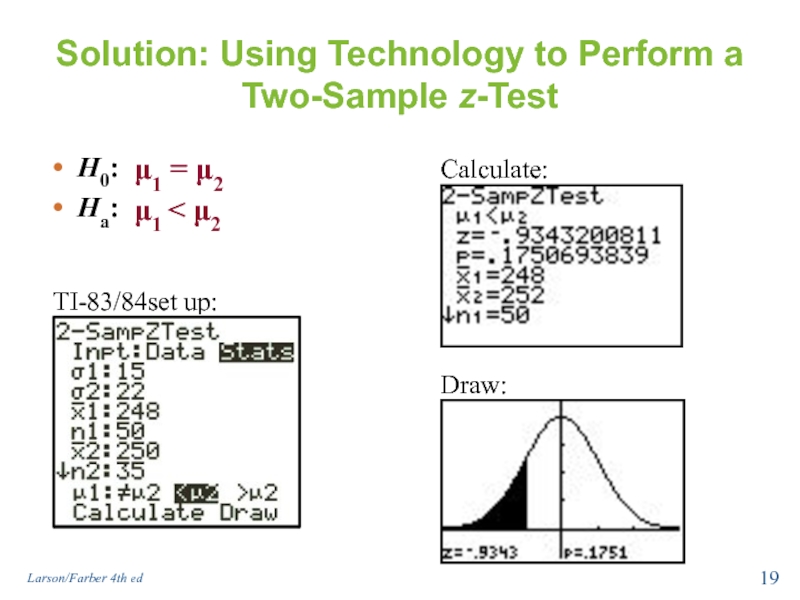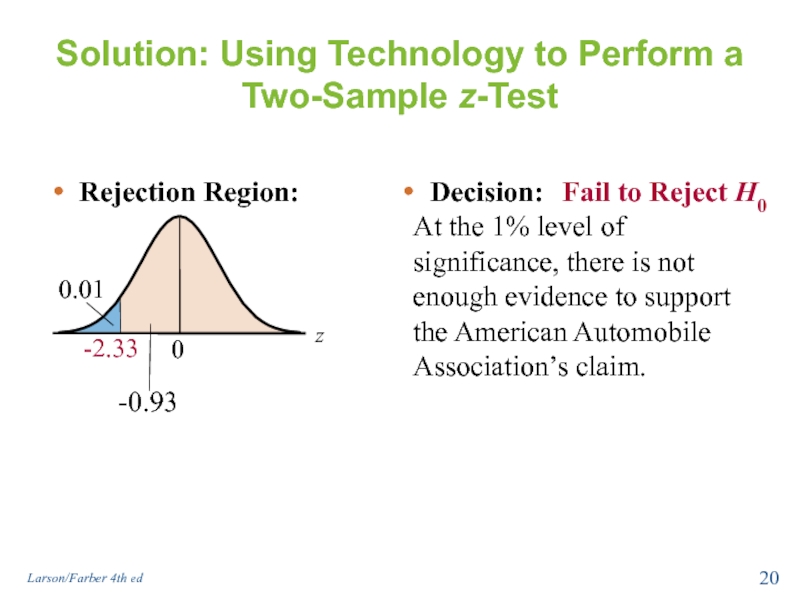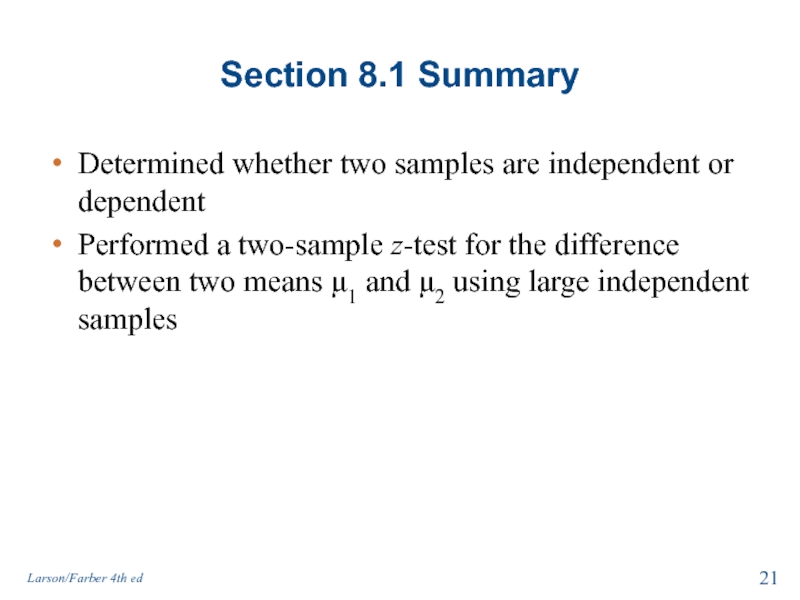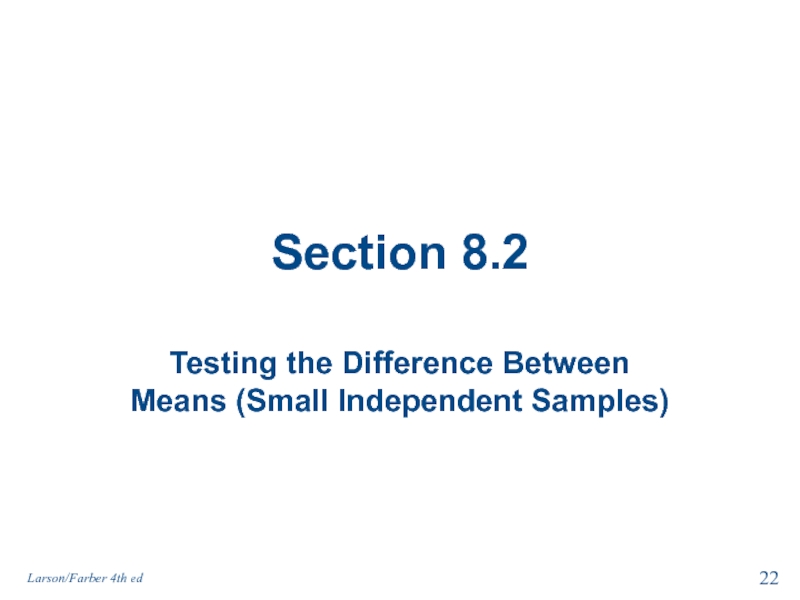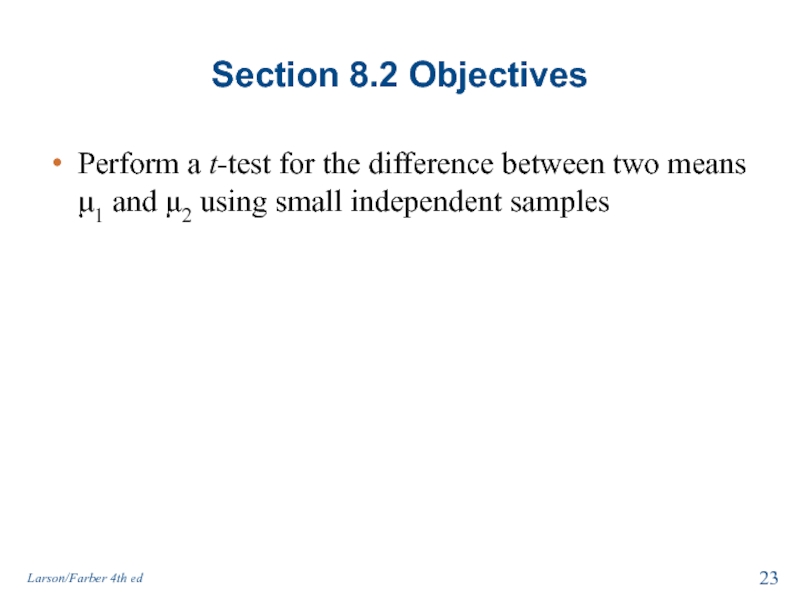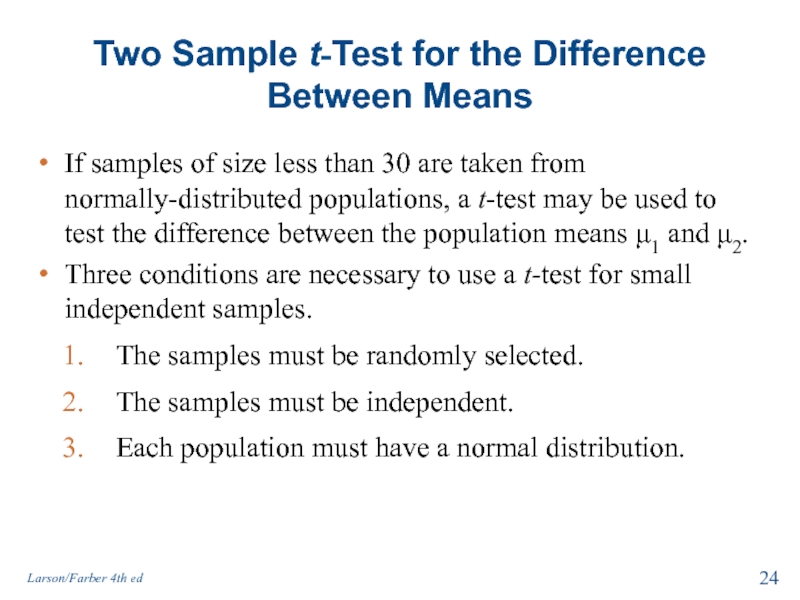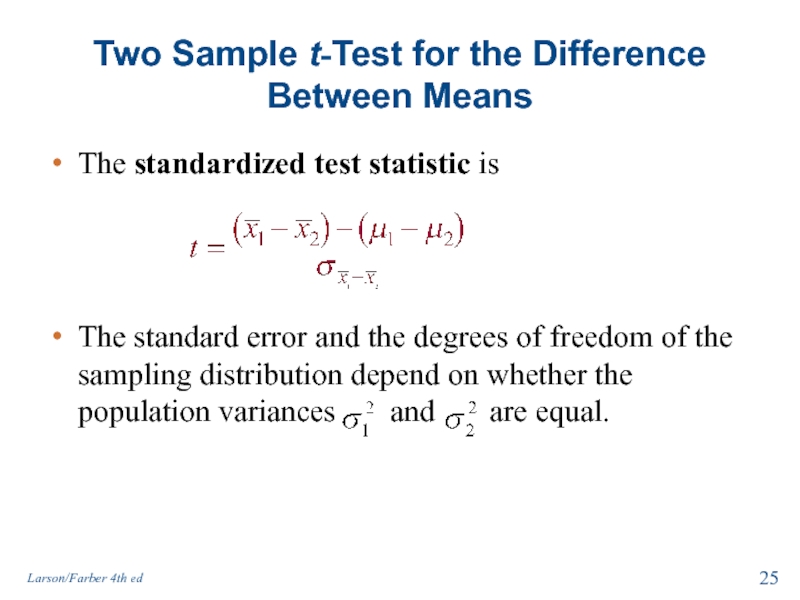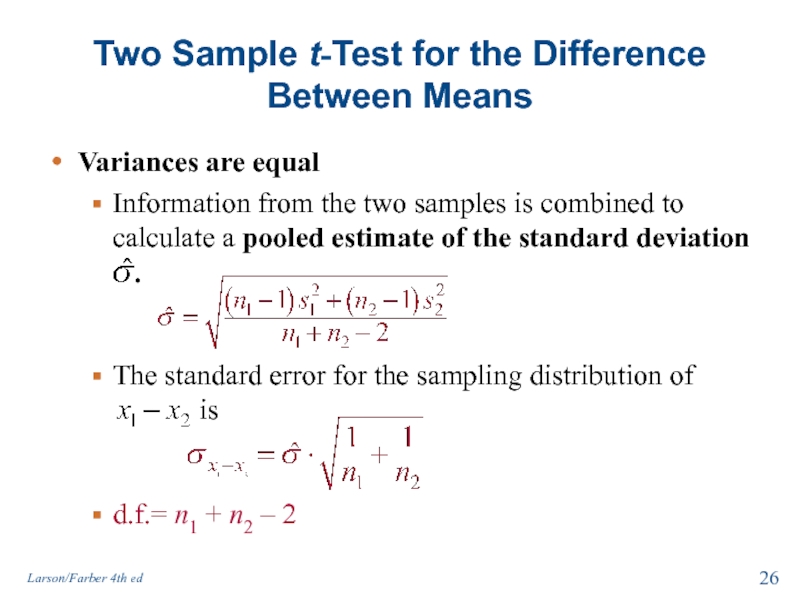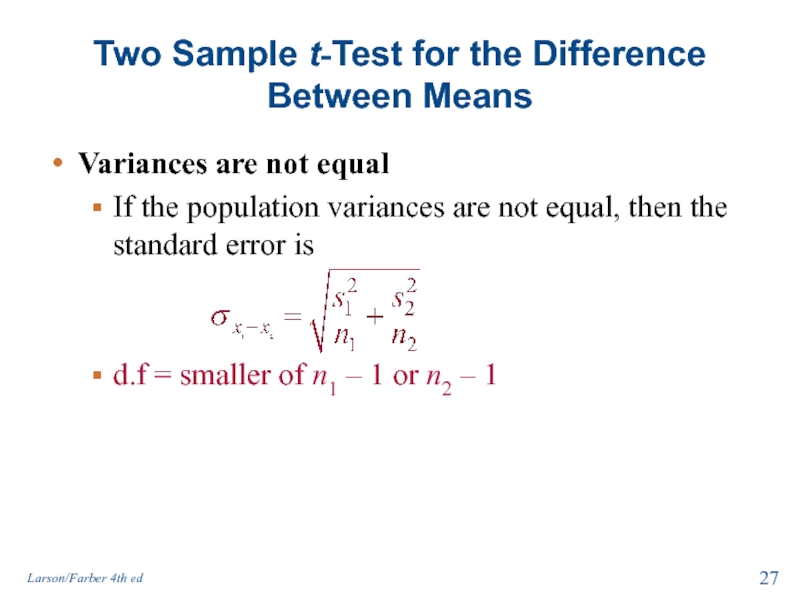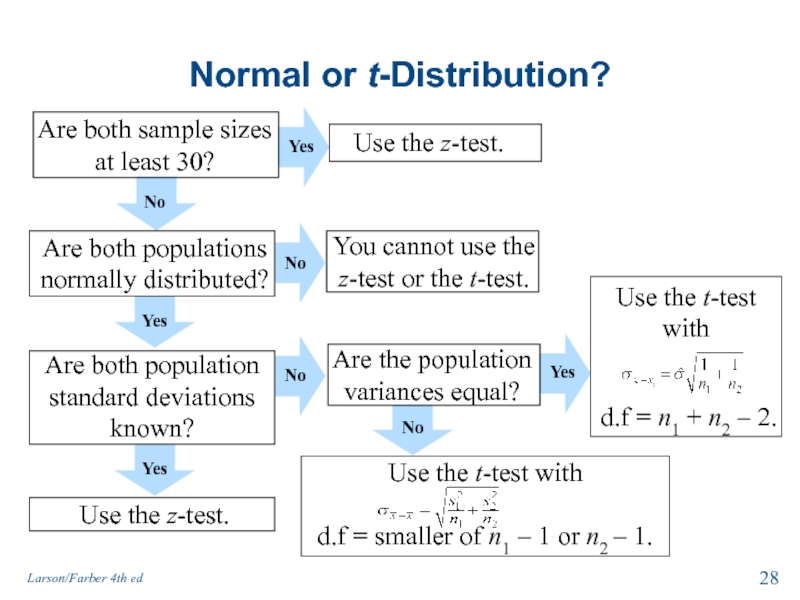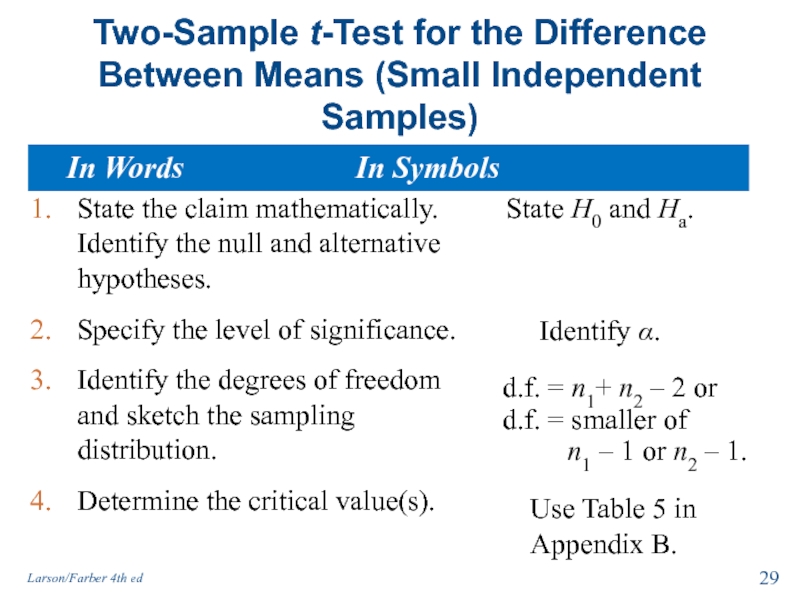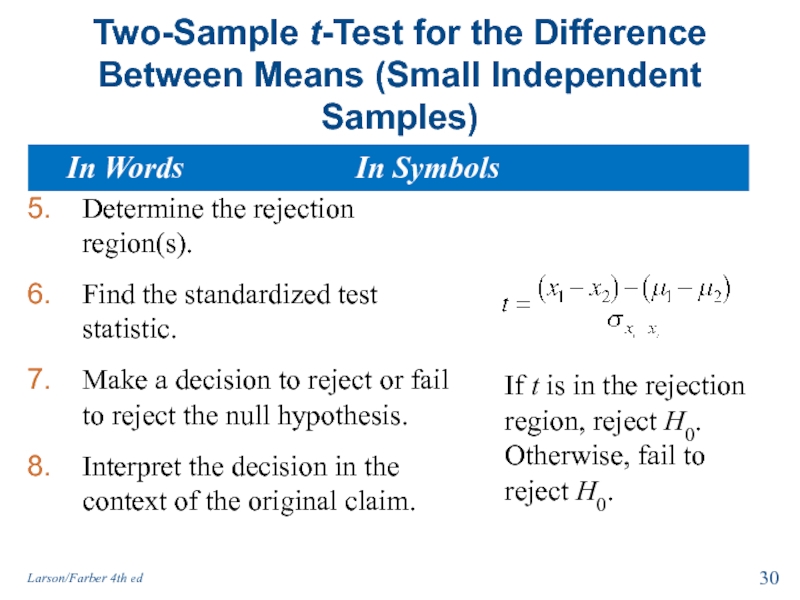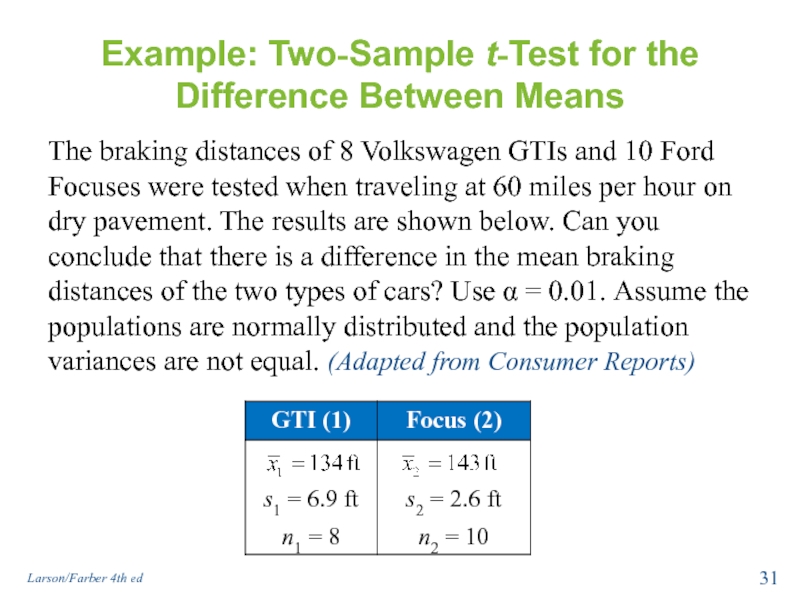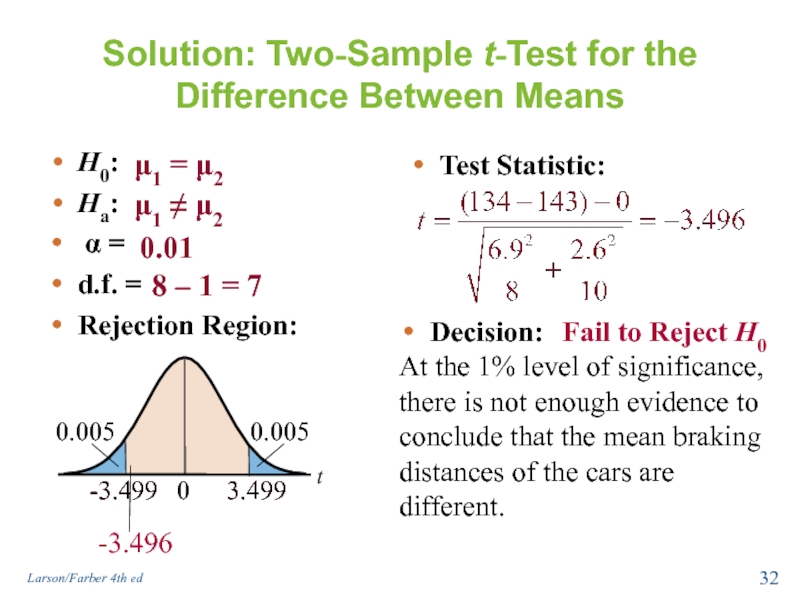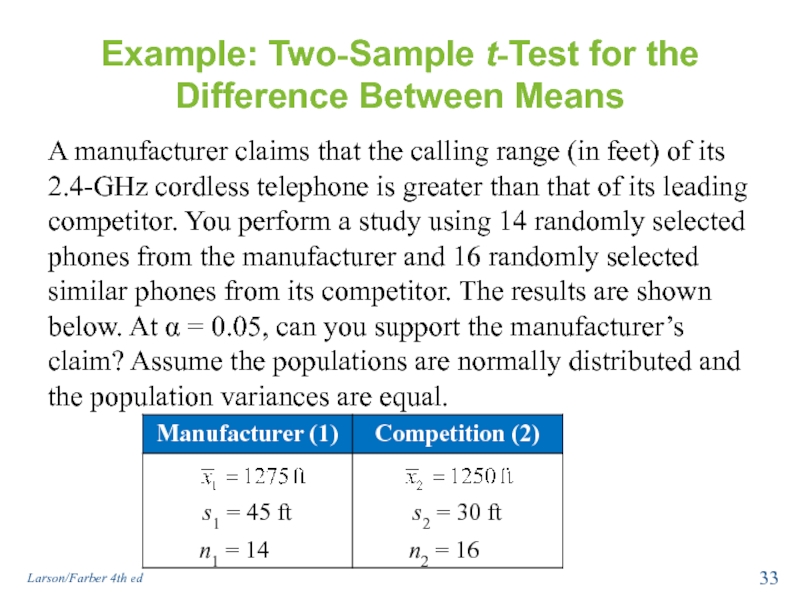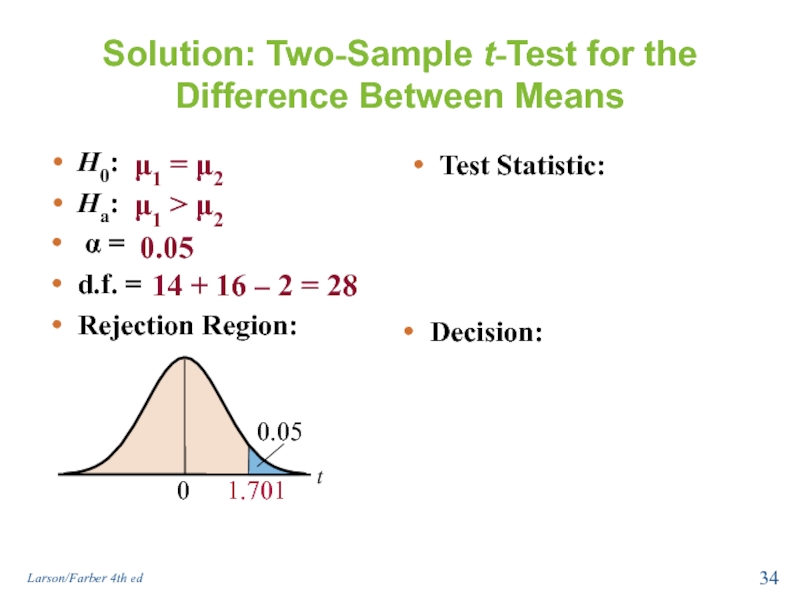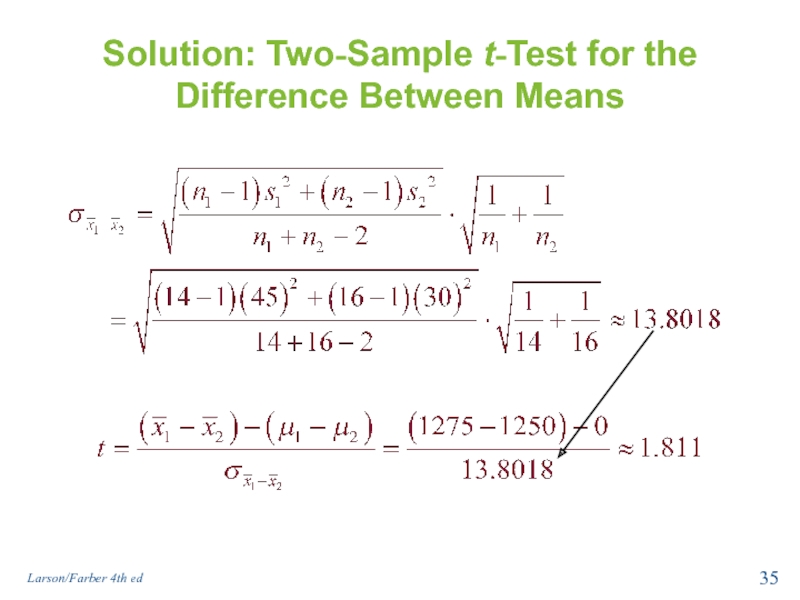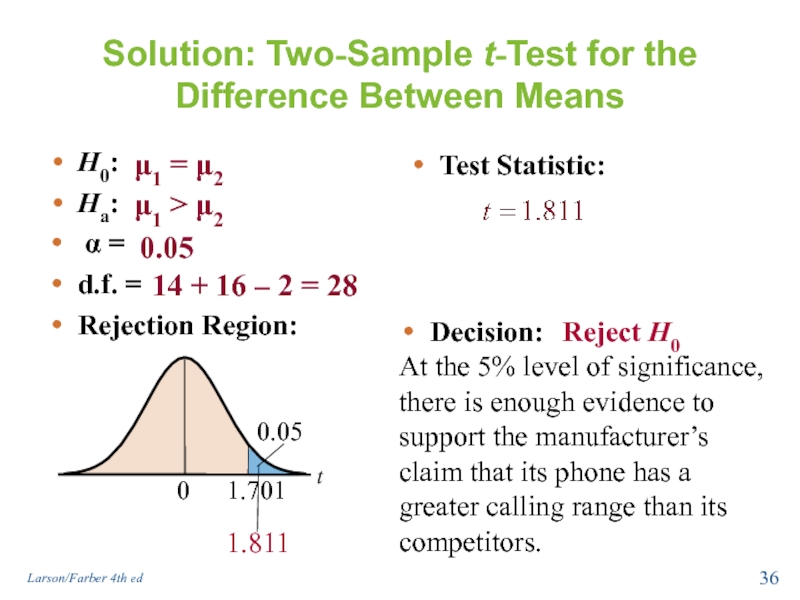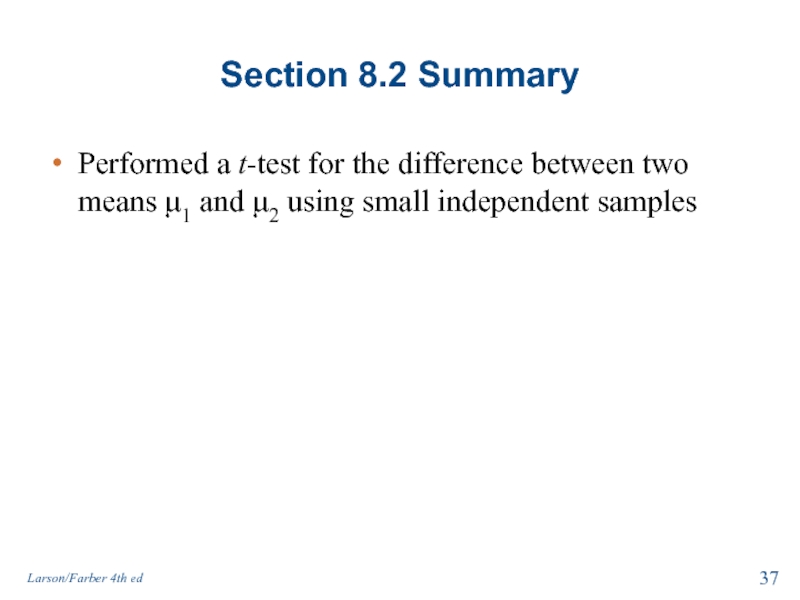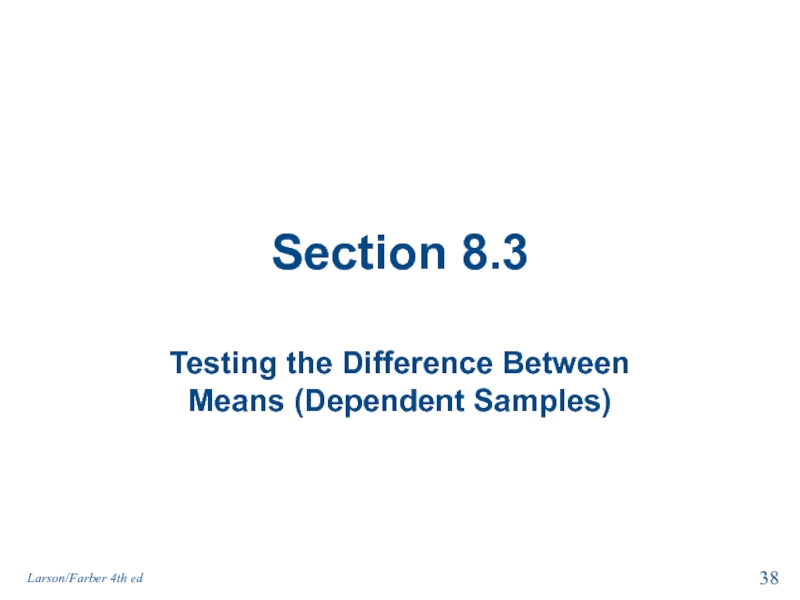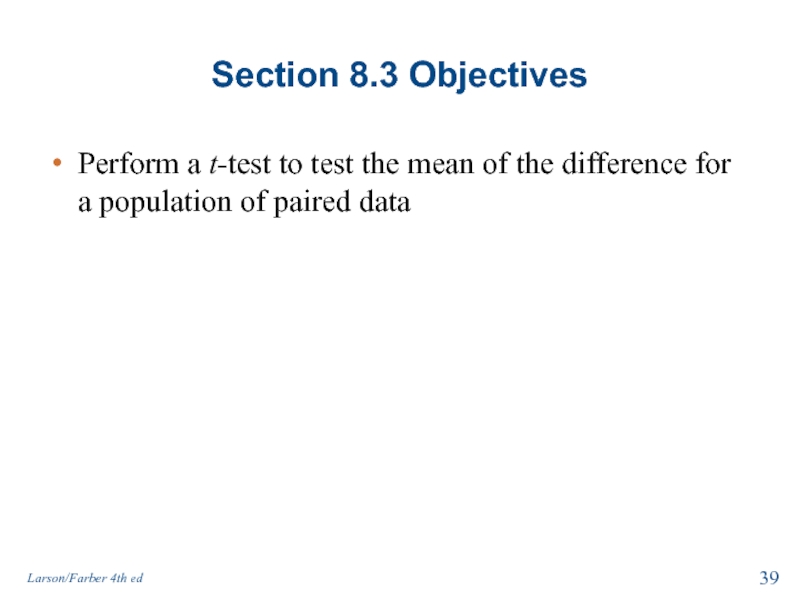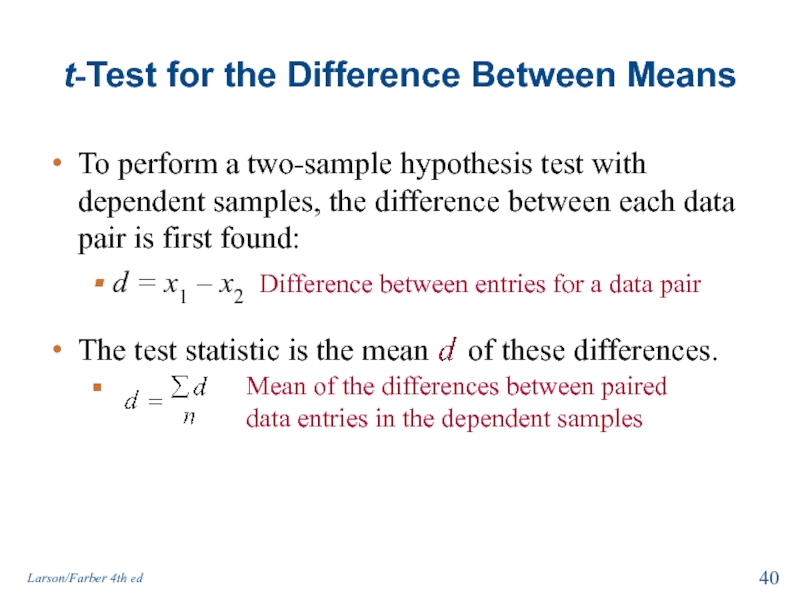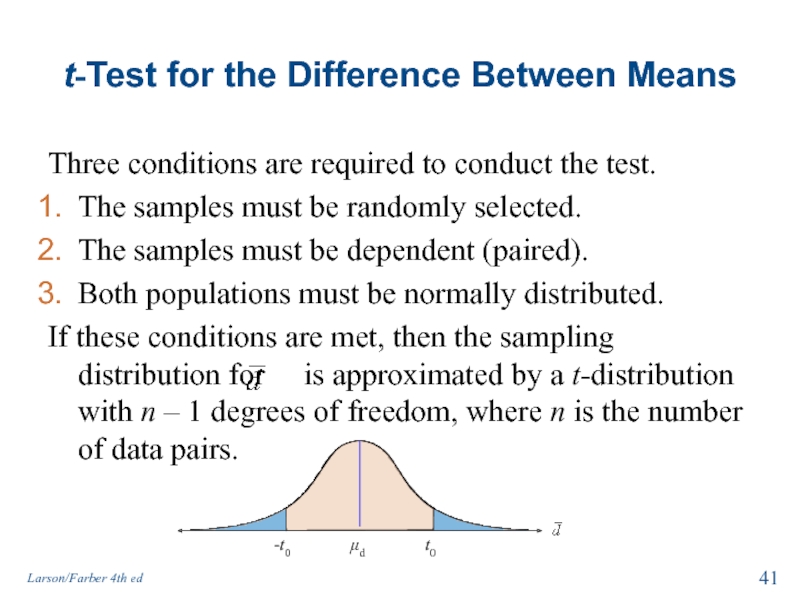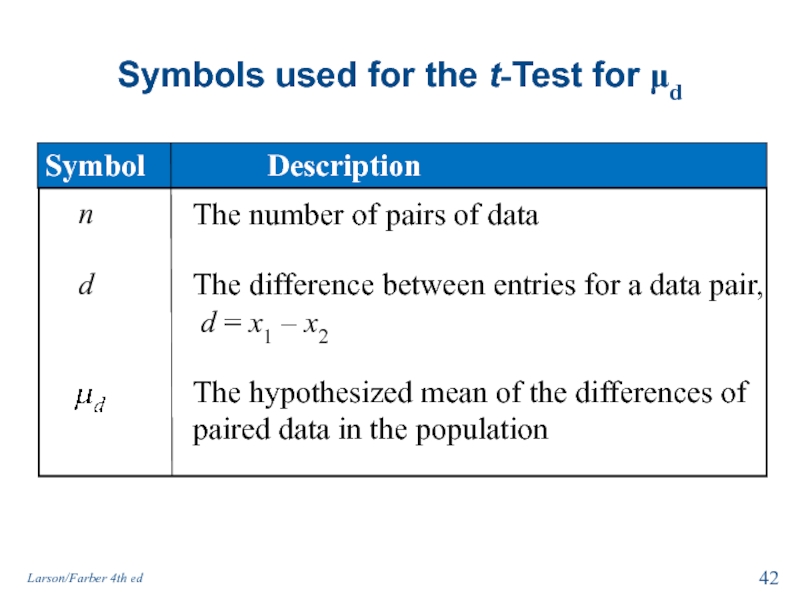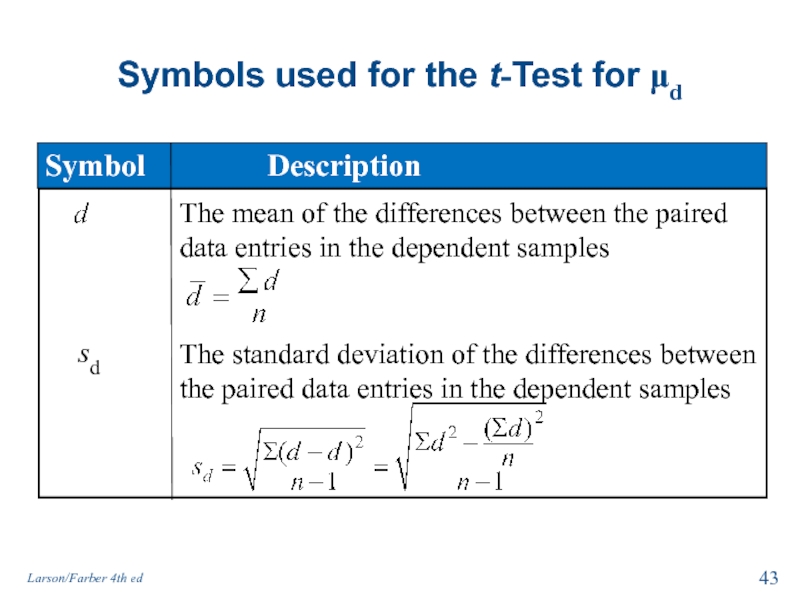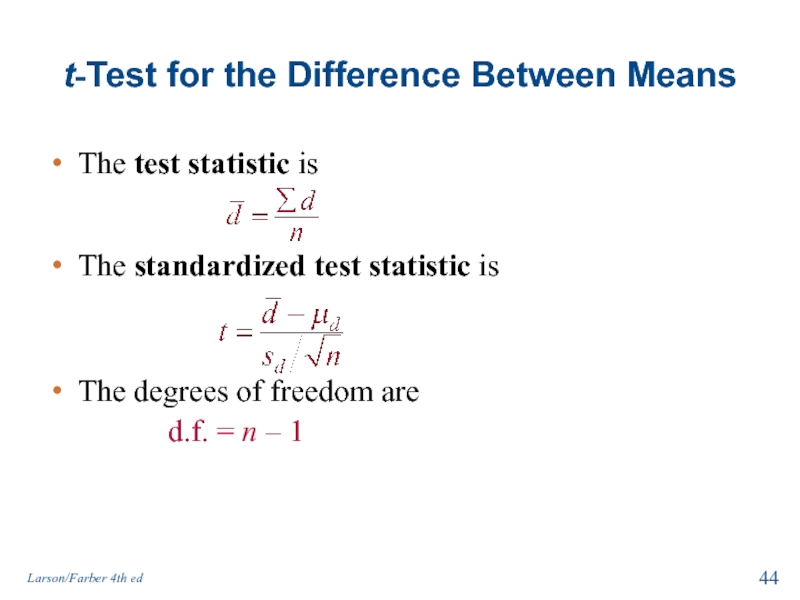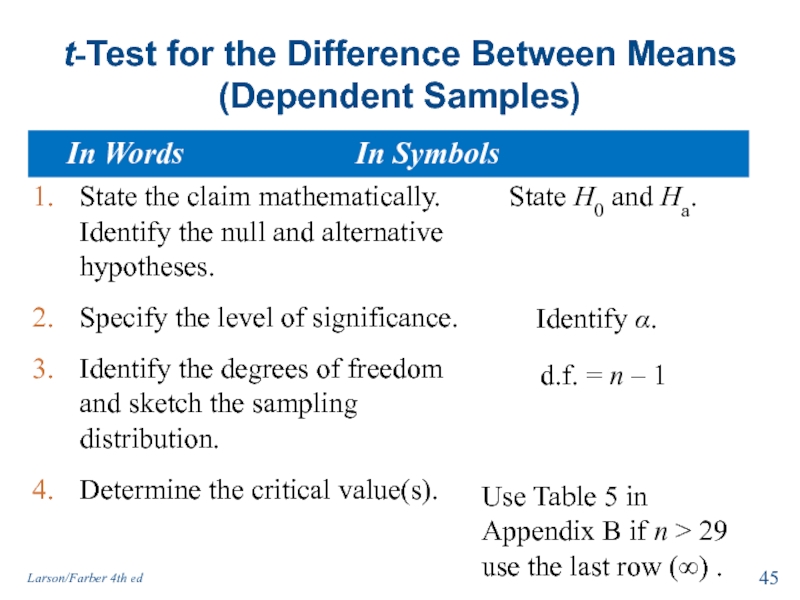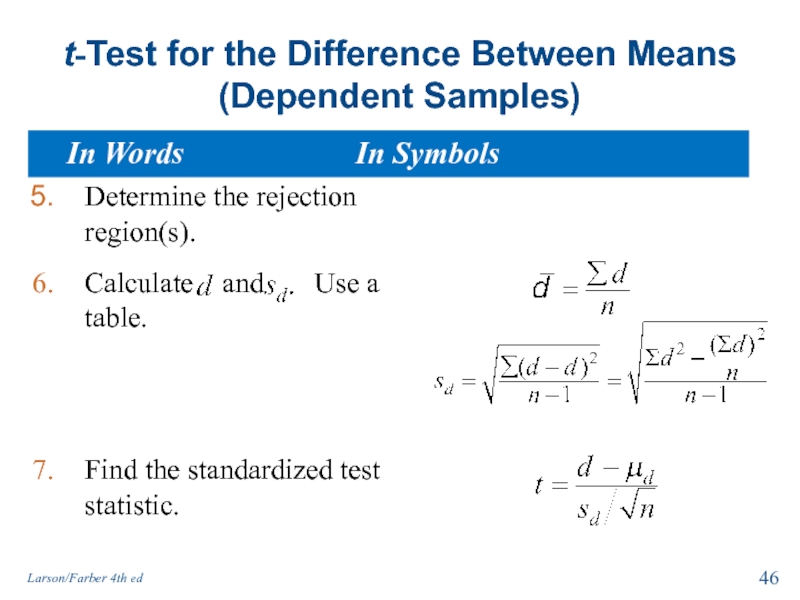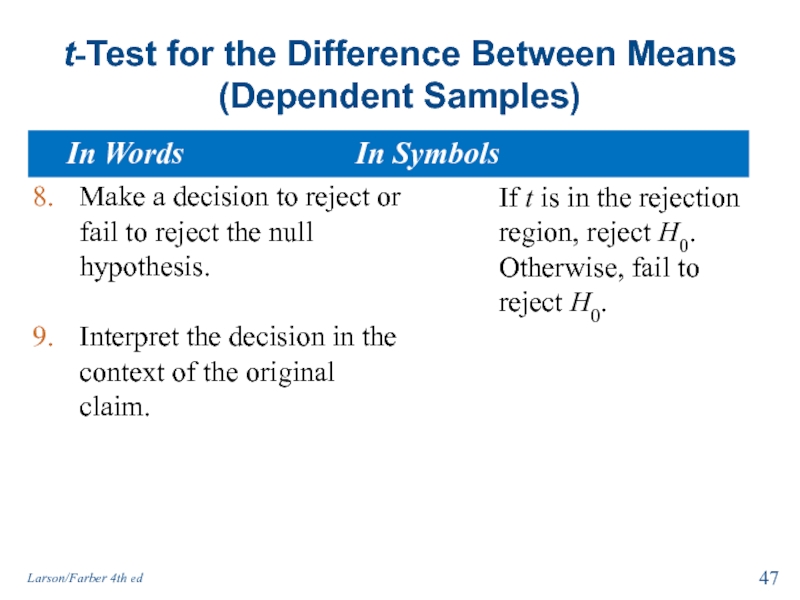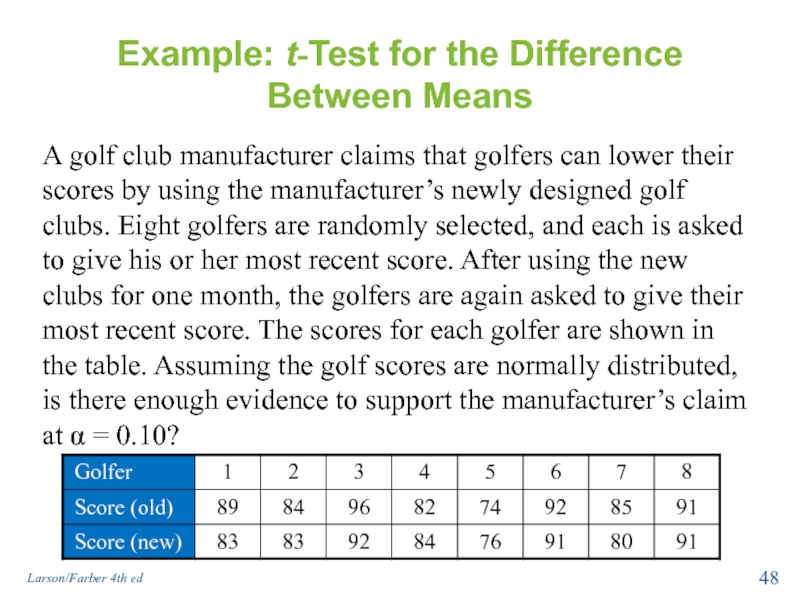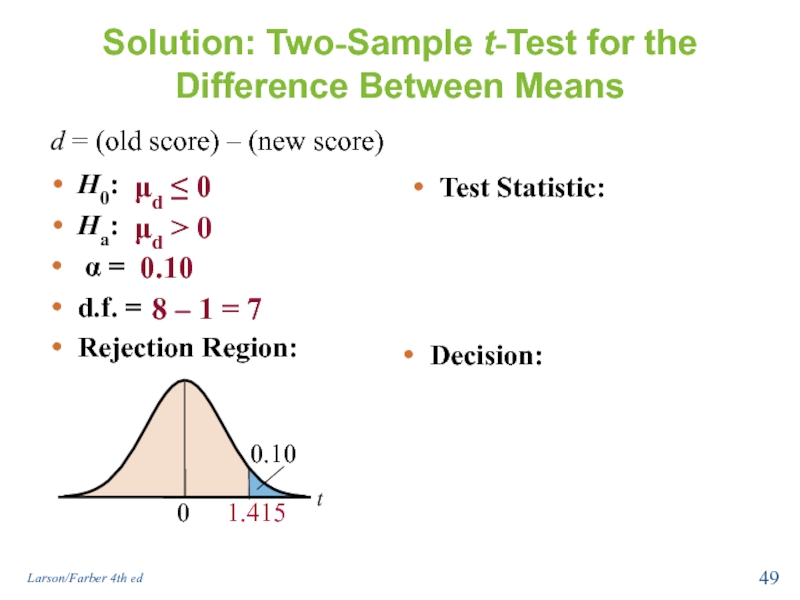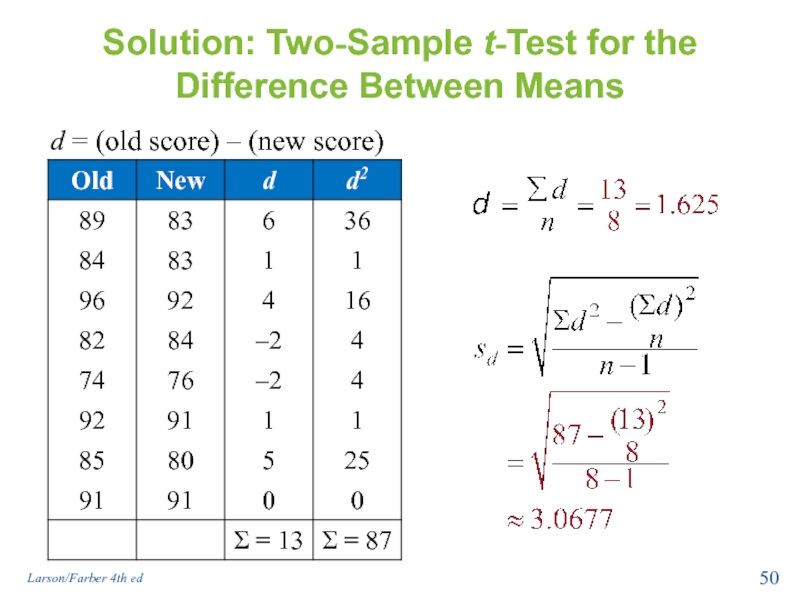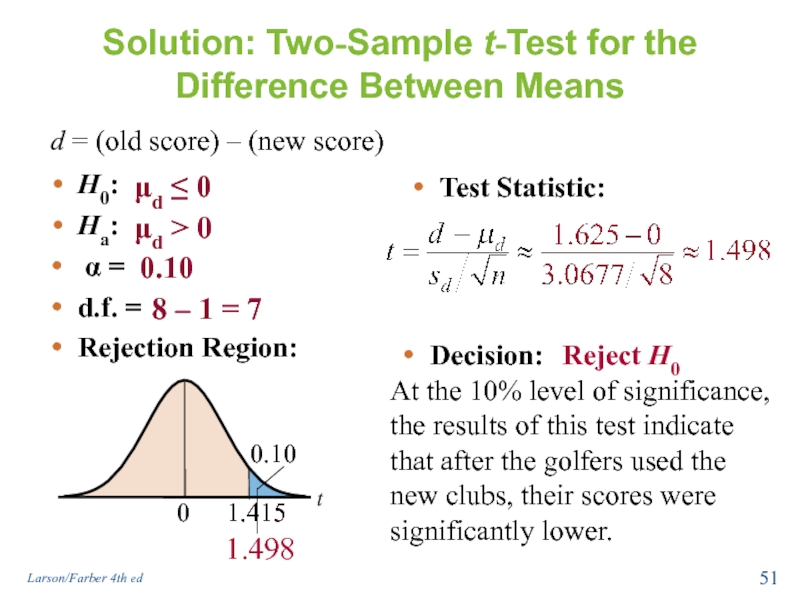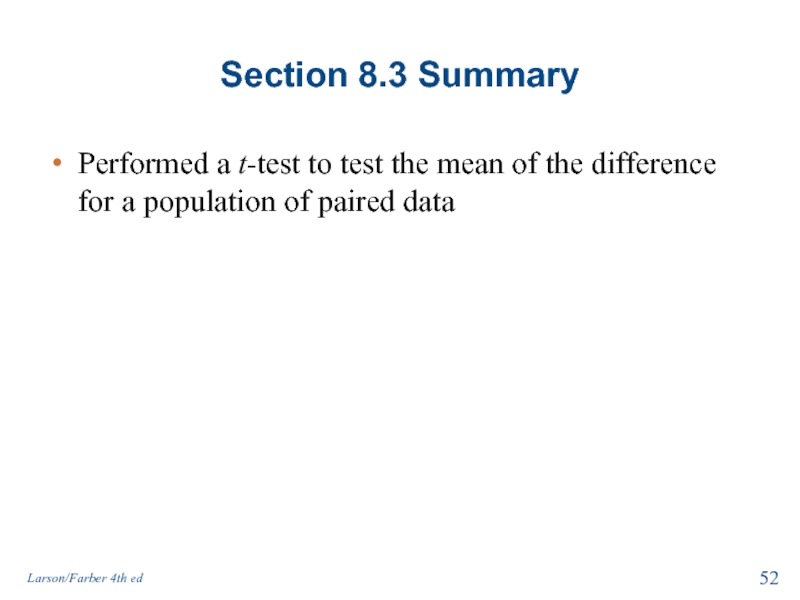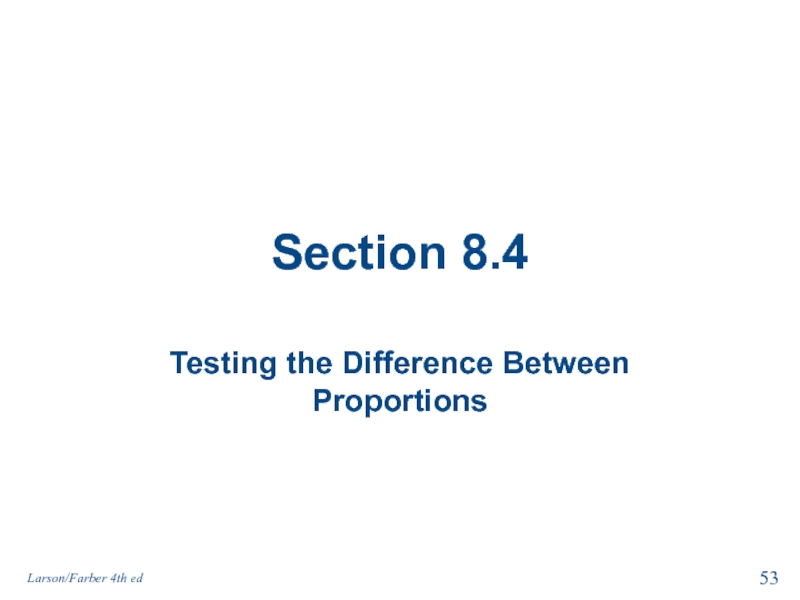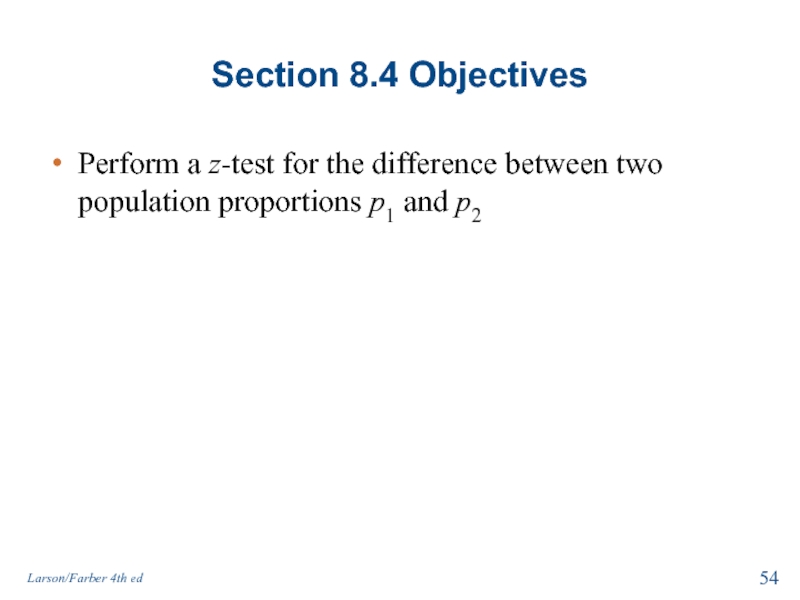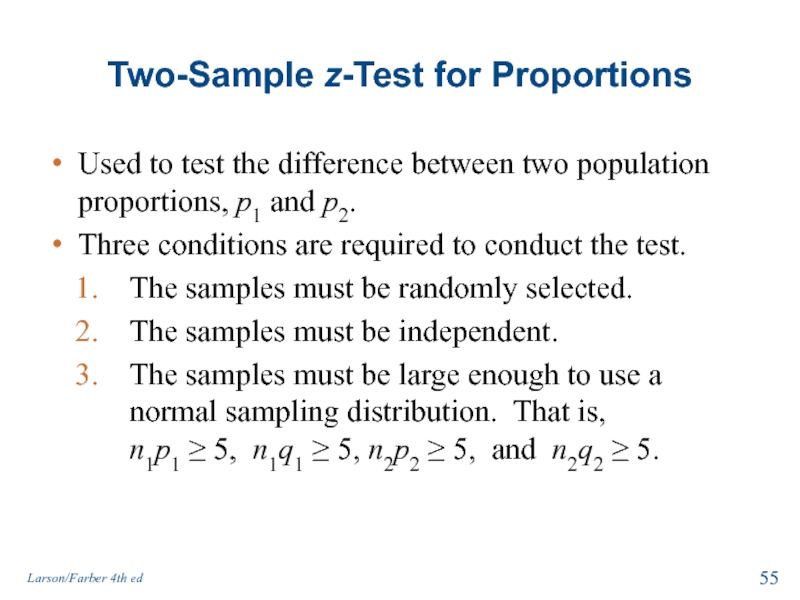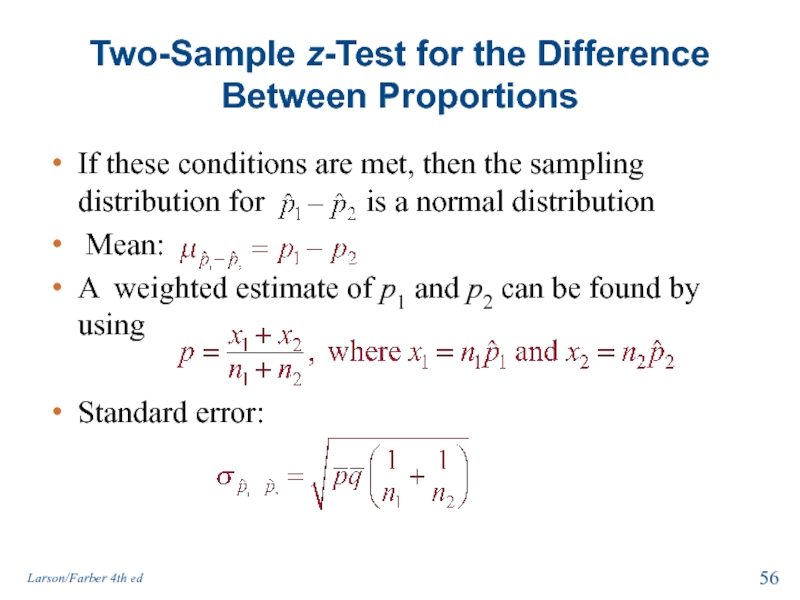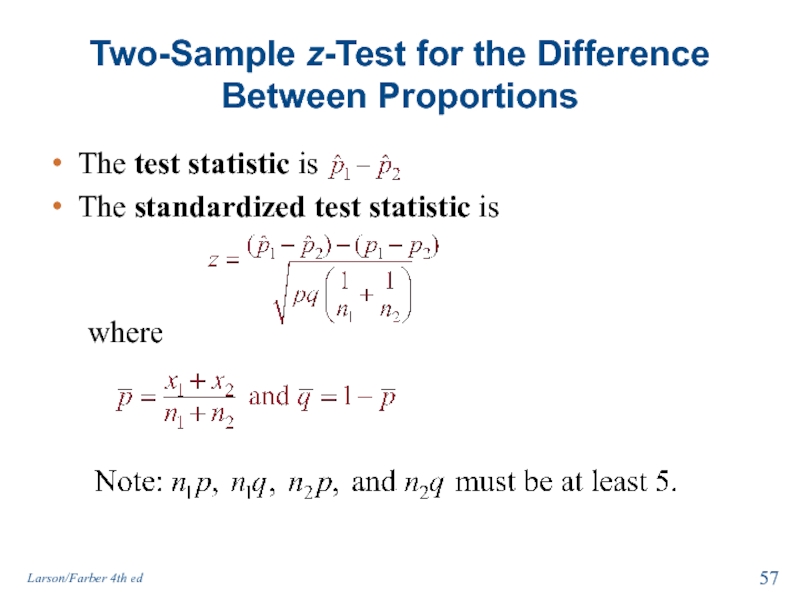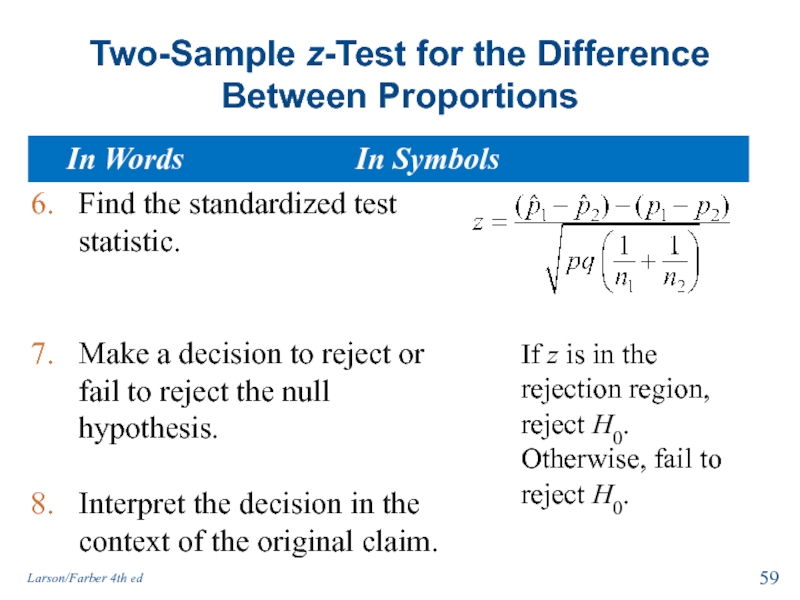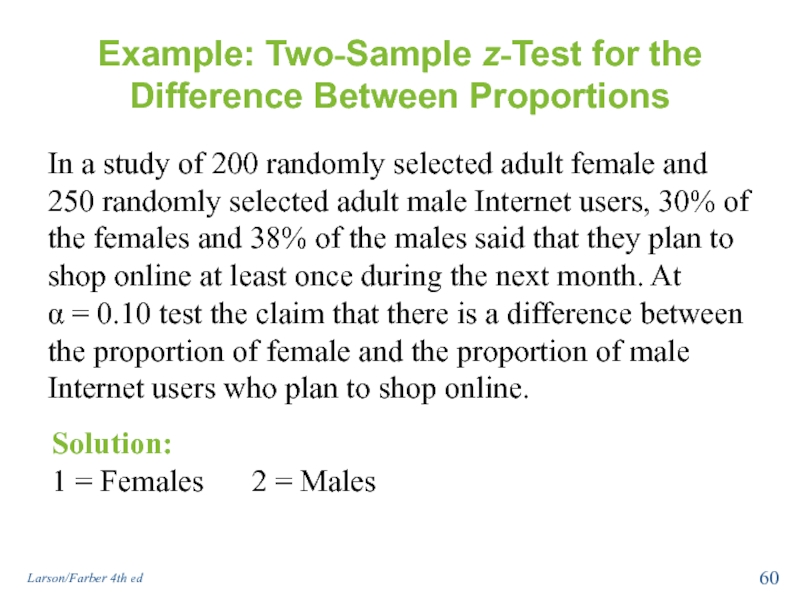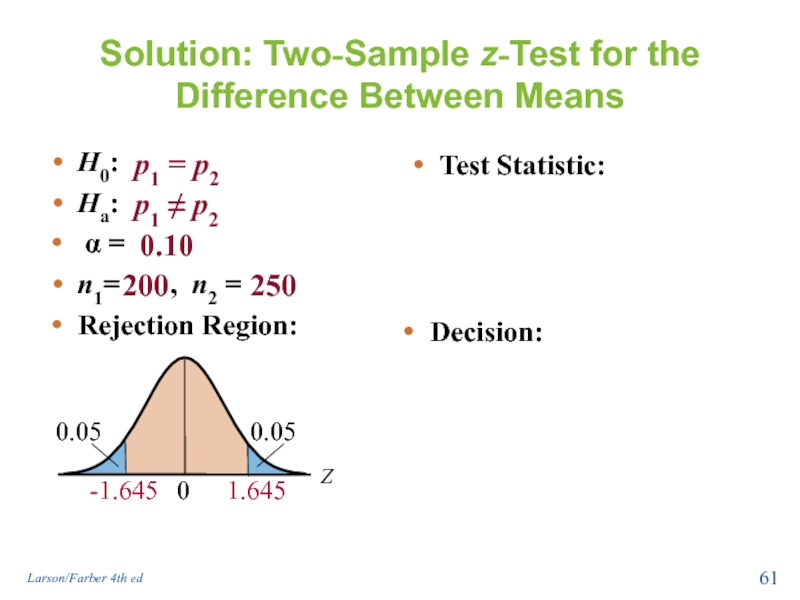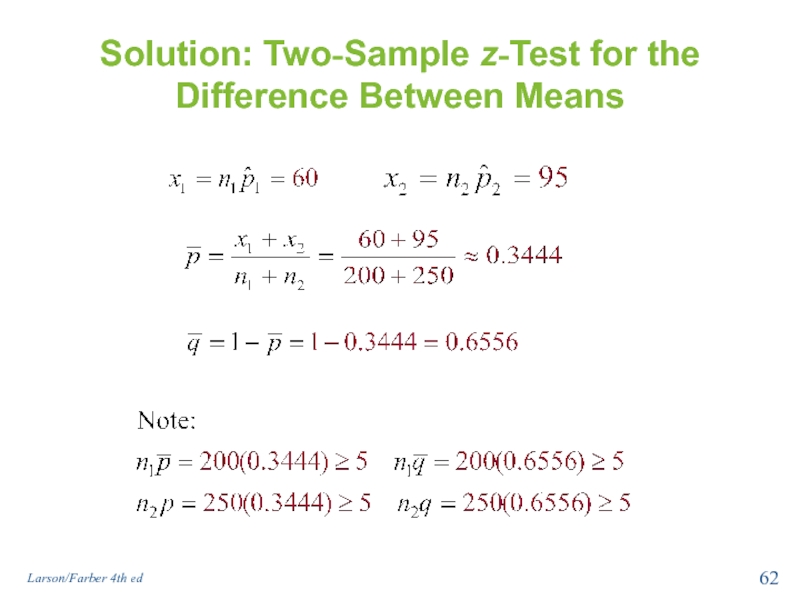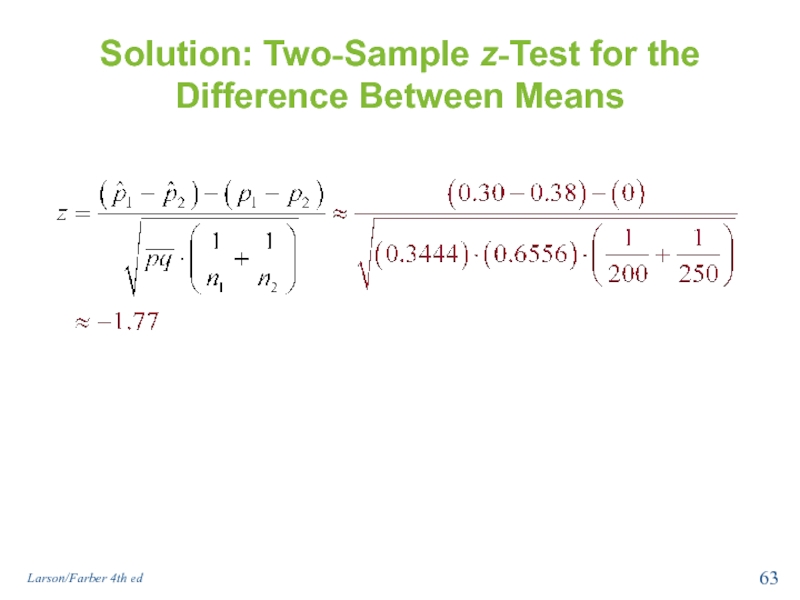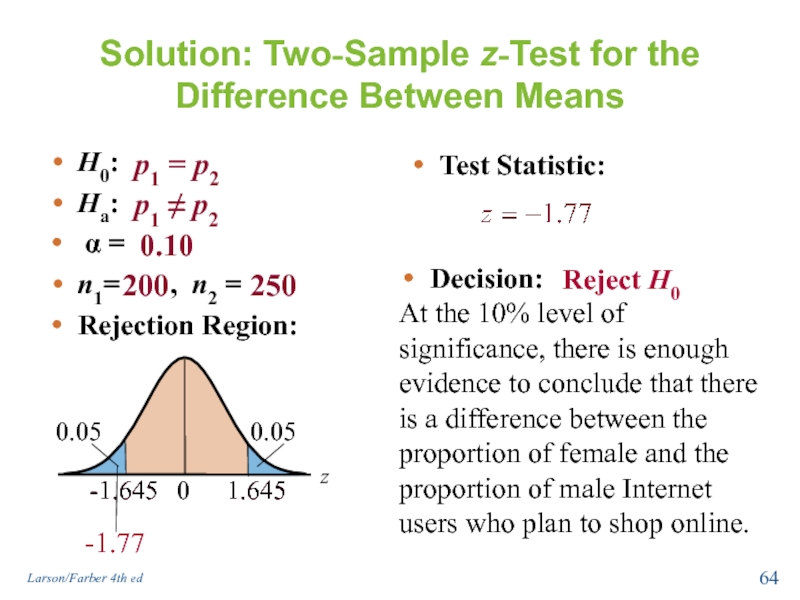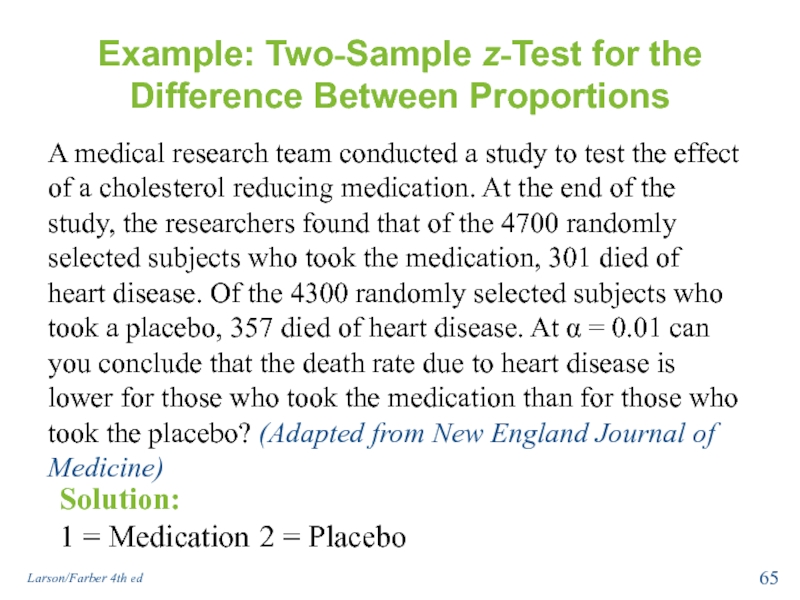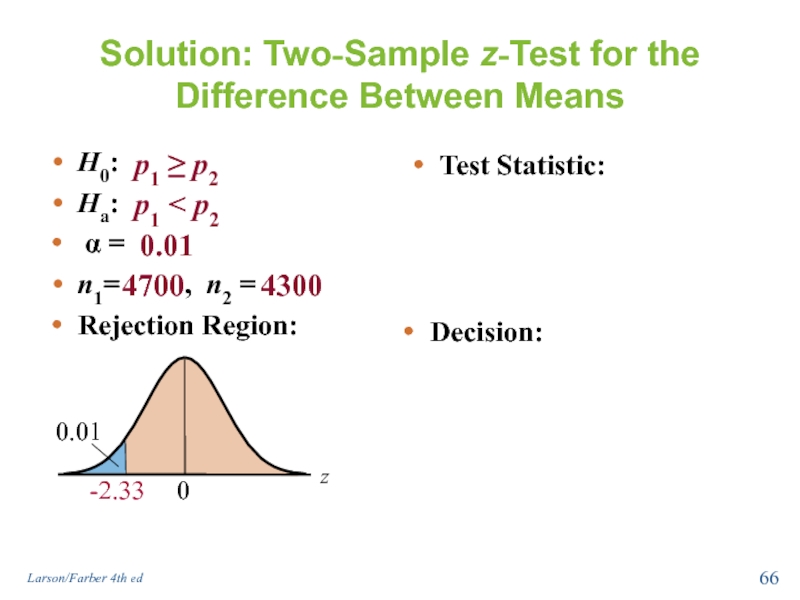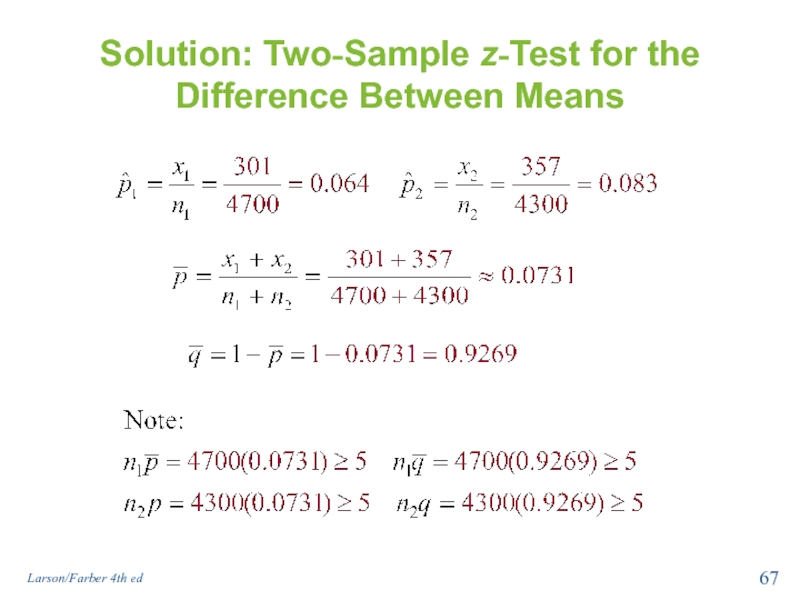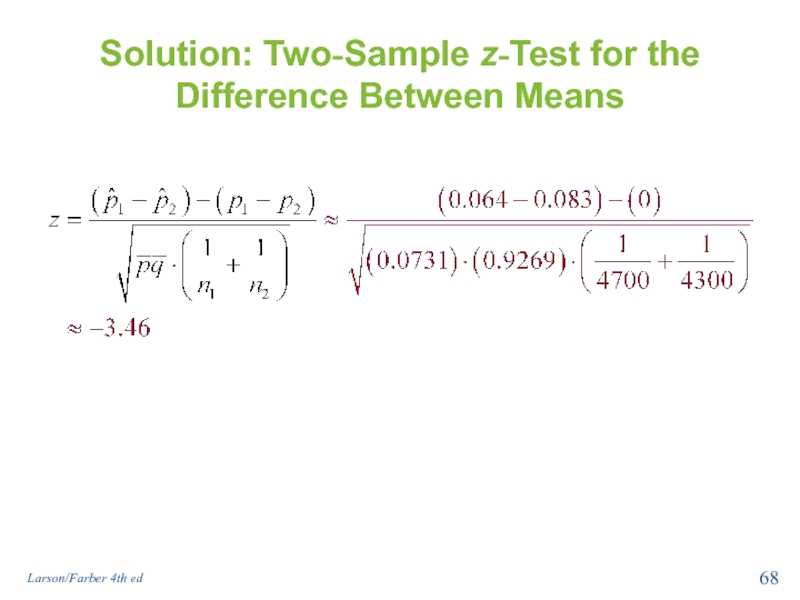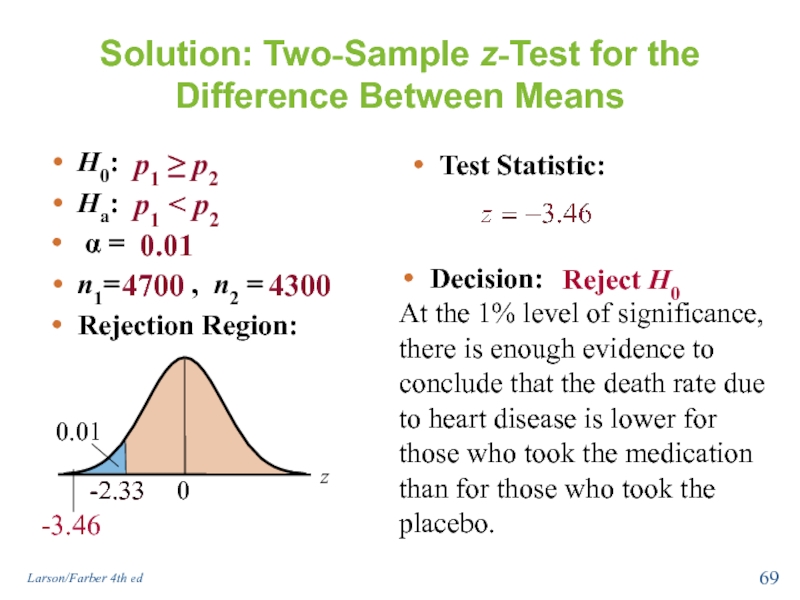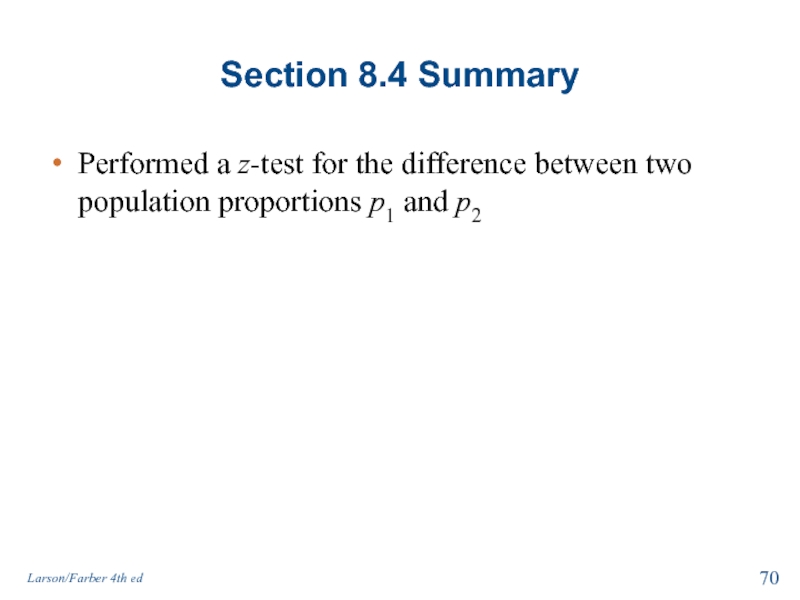- Главная
- Разное
- Дизайн
- Бизнес и предпринимательство
- Аналитика
- Образование
- Развлечения
- Красота и здоровье
- Финансы
- Государство
- Путешествия
- Спорт
- Недвижимость
- Армия
- Графика
- Культурология
- Еда и кулинария
- Лингвистика
- Английский язык
- Астрономия
- Алгебра
- Биология
- География
- Детские презентации
- Информатика
- История
- Литература
- Маркетинг
- Математика
- Медицина
- Менеджмент
- Музыка
- МХК
- Немецкий язык
- ОБЖ
- Обществознание
- Окружающий мир
- Педагогика
- Русский язык
- Технология
- Физика
- Философия
- Химия
- Шаблоны, картинки для презентаций
- Экология
- Экономика
- Юриспруденция
Hypothesis Testing with Two Samples презентация
Содержание
- 1. Hypothesis Testing with Two Samples
- 2. Chapter Outline 8.1 Testing the Difference Between
- 3. Section 8.1 Testing the Difference Between Means (Large Independent Samples) Larson/Farber 4th ed
- 4. Section 8.1 Objectives Determine whether two samples
- 5. Two Sample Hypothesis Test Compares two parameters
- 6. Independent and Dependent Samples Independent Samples
- 7. Example: Independent and Dependent Samples Classify the
- 8. Example: Independent and Dependent Samples Classify the
- 9. Two Sample Hypothesis Test with Independent Samples
- 10. Two Sample Hypothesis Test with Independent Samples
- 11. Two Sample z-Test for the Difference Between
- 12. Two Sample z-Test for the Difference Between
- 13. Two Sample z-Test for the Difference Between
- 14. Using a Two-Sample z-Test for the Difference
- 15. Using a Two-Sample z-Test for the Difference
- 16. Example: Two-Sample z-Test for the Difference Between
- 17. Solution: Two-Sample z-Test for the Difference Between
- 18. Example: Using Technology to Perform a Two-Sample
- 19. Solution: Using Technology to Perform a Two-Sample
- 20. Solution: Using Technology to Perform a Two-Sample
- 21. Section 8.1 Summary Determined whether two samples
- 22. Section 8.2 Testing the Difference Between Means (Small Independent Samples) Larson/Farber 4th ed
- 23. Section 8.2 Objectives Perform a t-test for
- 24. Two Sample t-Test for the Difference Between
- 25. Two Sample t-Test for the Difference Between
- 26. The standard error for the sampling distribution
- 27. Variances are not equal If the population
- 28. Normal or t-Distribution? Are both sample sizes
- 29. Two-Sample t-Test for the Difference Between Means
- 30. Two-Sample t-Test for the Difference Between Means
- 31. Example: Two-Sample t-Test for the Difference Between
- 32. Solution: Two-Sample t-Test for the Difference Between
- 33. Example: Two-Sample t-Test for the Difference Between
- 34. Solution: Two-Sample t-Test for the Difference Between
- 35. Solution: Two-Sample t-Test for the Difference Between Means Larson/Farber 4th ed
- 36. Solution: Two-Sample t-Test for the Difference Between
- 37. Section 8.2 Summary Performed a t-test for
- 38. Section 8.3 Testing the Difference Between Means (Dependent Samples) Larson/Farber 4th ed
- 39. Section 8.3 Objectives Perform a t-test to
- 40. The test statistic is the mean
- 41. t-Test for the Difference Between Means Three
- 42. Symbols used for the t-Test for μd
- 43. Symbols used for the t-Test for μd
- 44. t-Test for the Difference Between Means The
- 45. t-Test for the Difference Between Means (Dependent
- 46. t-Test for the Difference Between Means (Dependent
- 47. t-Test for the Difference Between Means (Dependent
- 48. Example: t-Test for the Difference Between Means
- 49. Solution: Two-Sample t-Test for the Difference Between
- 50. Solution: Two-Sample t-Test for the Difference Between
- 51. Solution: Two-Sample t-Test for the Difference Between
- 52. Section 8.3 Summary Performed a t-test to
- 53. Section 8.4 Testing the Difference Between Proportions Larson/Farber 4th ed
- 54. Section 8.4 Objectives Perform a z-test for
- 55. Two-Sample z-Test for Proportions Used to test
- 56. Two-Sample z-Test for the Difference Between Proportions
- 57. Two-Sample z-Test for the Difference Between Proportions
- 58. Two-Sample z-Test for the Difference Between Proportions
- 59. Two-Sample z-Test for the Difference Between Proportions
- 60. Example: Two-Sample z-Test for the Difference Between
- 61. Solution: Two-Sample z-Test for the Difference Between
- 62. Solution: Two-Sample z-Test for the Difference Between Means Larson/Farber 4th ed
- 63. Solution: Two-Sample z-Test for the Difference Between Means Larson/Farber 4th ed
- 64. Solution: Two-Sample z-Test for the Difference Between
- 65. Example: Two-Sample z-Test for the Difference Between
- 66. Solution: Two-Sample z-Test for the Difference Between
- 67. Solution: Two-Sample z-Test for the Difference Between Means Larson/Farber 4th ed
- 68. Solution: Two-Sample z-Test for the Difference Between Means Larson/Farber 4th ed
- 69. Solution: Two-Sample z-Test for the Difference Between
- 70. Section 8.4 Summary Performed a z-test for
Слайд 2Chapter Outline
8.1 Testing the Difference Between Means (Large
Independent
8.2 Testing the Difference Between Means (Small Independent Samples)
8.3 Testing the Difference Between Means (Dependent Samples)
8.4 Testing the Difference Between Proportions
Larson/Farber 4th ed
Слайд 3
Section 8.1
Testing the Difference Between Means (Large Independent Samples)
Larson/Farber 4th ed
Слайд 4Section 8.1 Objectives
Determine whether two samples are independent or dependent
Perform a
Larson/Farber 4th ed
Слайд 5Two Sample Hypothesis Test
Compares two parameters from two populations.
Sampling methods:
Independent Samples
The
Dependent Samples (paired or matched samples)
Each member of one sample corresponds to a member of the other sample.
Larson/Farber 4th ed
Слайд 6Independent and Dependent Samples
Independent Samples
Sample 1
Sample 2
Dependent Samples
Sample 1
Sample 2
Larson/Farber 4th
Слайд 7Example: Independent and Dependent Samples
Classify the pair of samples as independent
Sample 1: Resting heart rates of 35 individuals before drinking coffee.
Sample 2: Resting heart rates of the same individuals after drinking two cups of coffee.
Solution:
Dependent Samples (The samples can be paired with respect to each individual)
Larson/Farber 4th ed
Слайд 8Example: Independent and Dependent Samples
Classify the pair of samples as independent
Sample 1: Test scores for 35 statistics students.
Sample 2: Test scores for 42 biology students who do not study statistics.
Solution:
Independent Samples (Not possible to form a pairing between the members of the samples; the sample sizes are different, and the data represent scores for different individuals.)
Larson/Farber 4th ed
Слайд 9Two Sample Hypothesis Test with Independent Samples
Null hypothesis H0
A statistical
Always contains the symbol =.
Alternative hypothesis Ha
A statistical hypothesis that is supported when H0 is rejected.
Always contains the symbol >, ≠, or <.
Larson/Farber 4th ed
Слайд 10Two Sample Hypothesis Test with Independent Samples
H0: μ1 = μ2
Ha: μ1
H0: μ1 = μ2
Ha: μ1 > μ2
H0: μ1 = μ2
Ha: μ1 < μ2
Regardless of which hypotheses you use, you always assume there is no difference between the population means, or μ1 = μ2.
Larson/Farber 4th ed
Слайд 11Two Sample z-Test for the Difference Between Means
Three conditions are necessary
The samples must be randomly selected.
The samples must be independent.
Each sample size must be at least 30, or, if not, each population must have a normal distribution with a known standard deviation.
Larson/Farber 4th ed
Слайд 12Two Sample z-Test for the Difference Between Means
If these requirements are
Mean:
Standard error:
Larson/Farber 4th ed
Слайд 13Two Sample z-Test for the Difference Between Means
Test statistic is
The standardized test statistic is
When the samples are large, you can use s1 and s2 in place of σ1 and σ2. If the samples are not large, you can still use a two-sample z-test, provided the populations are normally distributed and the population standard deviations are known.
Larson/Farber 4th ed
Слайд 14Using a Two-Sample z-Test for the Difference Between Means (Large Independent
State the claim mathematically. Identify the null and alternative hypotheses.
Specify the level of significance.
Sketch the sampling distribution.
Determine the critical value(s).
Determine the rejection region(s).
State H0 and Ha.
Identify α.
Use Table 4 in Appendix B.
In Words In Symbols
Larson/Farber 4th ed
Слайд 15Using a Two-Sample z-Test for the Difference Between Means (Large Independent
Find the standardized test statistic.
Make a decision to reject or fail to reject the null hypothesis.
Interpret the decision in the context of the original claim.
If z is in the rejection region, reject H0. Otherwise, fail to reject H0.
In Words In Symbols
Larson/Farber 4th ed
Слайд 16Example: Two-Sample z-Test for the Difference Between Means
A consumer education organization
Larson/Farber 4th ed
Слайд 17Solution: Two-Sample z-Test for the Difference Between Means
H0:
Ha:
α =
n1=
Rejection Region:
Test Statistic:
-1.96
1.96
-1.03
Decision:
At the 5% level of significance, there is not enough evidence to support the organization’s claim that there is a difference in the mean credit card debt of males and females.
Fail to Reject H0
Larson/Farber 4th ed
Слайд 18Example: Using Technology to Perform a Two-Sample z-Test
The American Automobile Association
Larson/Farber 4th ed
Слайд 19Solution: Using Technology to Perform a Two-Sample z-Test
H0:
Ha:
TI-83/84set up:
Calculate:
Draw:
Larson/Farber 4th ed
Слайд 20Solution: Using Technology to Perform a Two-Sample z-Test
Decision:
At the 1% level
Fail to Reject H0
Rejection Region:
-0.93
-2.33
Larson/Farber 4th ed
Слайд 21Section 8.1 Summary
Determined whether two samples are independent or dependent
Performed a
Larson/Farber 4th ed
Слайд 22Section 8.2
Testing the Difference Between Means (Small Independent Samples)
Larson/Farber 4th ed
Слайд 23Section 8.2 Objectives
Perform a t-test for the difference between two means
Larson/Farber 4th ed
Слайд 24Two Sample t-Test for the Difference Between Means
If samples of size
Three conditions are necessary to use a t-test for small independent samples.
The samples must be randomly selected.
The samples must be independent.
Each population must have a normal distribution.
Larson/Farber 4th ed
Слайд 25Two Sample t-Test for the Difference Between Means
The standardized test statistic
The standard error and the degrees of freedom of the sampling distribution depend on whether the population variances and are equal.
Larson/Farber 4th ed
Слайд 26The standard error for the sampling distribution of
Two Sample t-Test for the Difference Between Means
Variances are equal
Information from the two samples is combined to calculate a pooled estimate of the standard deviation
.
d.f.= n1 + n2 – 2
Larson/Farber 4th ed
Слайд 27Variances are not equal
If the population variances are not equal, then
d.f = smaller of n1 – 1 or n2 – 1
Two Sample t-Test for the Difference Between Means
Larson/Farber 4th ed
Слайд 28Normal or t-Distribution?
Are both sample sizes
Are both populations normally distributed?
You cannot use the z-test or the t-test.
Are both population standard deviations known?
Use the z-test.
Are the population variances equal?
Use the z-test.
d.f = n1 + n2 – 2.
Larson/Farber 4th ed
Слайд 29Two-Sample t-Test for the Difference Between Means (Small Independent Samples)
State the
Specify the level of significance.
Identify the degrees of freedom and sketch the sampling distribution.
Determine the critical value(s).
State H0 and Ha.
Identify α.
Use Table 5 in Appendix B.
d.f. = n1+ n2 – 2 or
d.f. = smaller of
n1 – 1 or n2 – 1.
In Words In Symbols
Larson/Farber 4th ed
Слайд 30Two-Sample t-Test for the Difference Between Means (Small Independent Samples)
Determine the
Find the standardized test statistic.
Make a decision to reject or fail to reject the null hypothesis.
Interpret the decision in the context of the original claim.
If t is in the rejection region, reject H0. Otherwise, fail to reject H0.
In Words In Symbols
Larson/Farber 4th ed
Слайд 31Example: Two-Sample t-Test for the Difference Between Means
The braking distances of
Larson/Farber 4th ed
Слайд 32Solution: Two-Sample t-Test for the Difference Between Means
H0:
Ha:
α =
d.f.
Rejection Region:
Test Statistic:
-3.499
3.499
-3.496
Decision:
At the 1% level of significance, there is not enough evidence to conclude that the mean braking distances of the cars are different.
Fail to Reject H0
Larson/Farber 4th ed
Слайд 33Example: Two-Sample t-Test for the Difference Between Means
A manufacturer claims that
Larson/Farber 4th ed
Слайд 34Solution: Two-Sample t-Test for the Difference Between Means
H0:
Ha:
α =
d.f.
Rejection Region:
Test Statistic:
Decision:
Larson/Farber 4th ed
Слайд 36Solution: Two-Sample t-Test for the Difference Between Means
H0:
Ha:
α =
d.f.
Rejection Region:
Test Statistic:
1.811
Decision:
At the 5% level of significance, there is enough evidence to support the manufacturer’s claim that its phone has a greater calling range than its competitors.
Reject H0
Larson/Farber 4th ed
Слайд 37Section 8.2 Summary
Performed a t-test for the difference between two means
Larson/Farber 4th ed
Слайд 39Section 8.3 Objectives
Perform a t-test to test the mean of the
Larson/Farber 4th ed
Слайд 40The test statistic is the mean of these differences.
t-Test for the Difference Between Means
To perform a two-sample hypothesis test with dependent samples, the difference between each data pair is first found:
d = x1 – x2 Difference between entries for a data pair
Mean of the differences between paired data entries in the dependent samples
Larson/Farber 4th ed
Слайд 41t-Test for the Difference Between Means
Three conditions are required to conduct
The samples must be randomly selected.
The samples must be dependent (paired).
Both populations must be normally distributed.
If these conditions are met, then the sampling distribution for is approximated by a t-distribution with n – 1 degrees of freedom, where n is the number of data pairs.
Larson/Farber 4th ed
Слайд 42Symbols used for the t-Test for μd
The number of pairs of
The difference between entries for a data pair,
d = x1 – x2
The hypothesized mean of the differences of paired data in the population
n
d
Larson/Farber 4th ed
Слайд 43Symbols used for the t-Test for μd
The mean of the differences
The standard deviation of the differences between the paired data entries in the dependent samples
sd
Larson/Farber 4th ed
Слайд 44t-Test for the Difference Between Means
The test statistic is
The standardized test
The degrees of freedom are
d.f. = n – 1
Larson/Farber 4th ed
Слайд 45t-Test for the Difference Between Means (Dependent Samples)
State the claim mathematically.
Specify the level of significance.
Identify the degrees of freedom and sketch the sampling distribution.
Determine the critical value(s).
State H0 and Ha.
Identify α.
Use Table 5 in Appendix B if n > 29 use the last row (∞) .
d.f. = n – 1
In Words In Symbols
Larson/Farber 4th ed
Слайд 46t-Test for the Difference Between Means (Dependent Samples)
Determine the rejection region(s).
Calculate
Find the standardized test statistic.
In Words In Symbols
Larson/Farber 4th ed
Слайд 47t-Test for the Difference Between Means (Dependent Samples)
Make a decision to
Interpret the decision in the context of the original claim.
If t is in the rejection region, reject H0. Otherwise, fail to reject H0.
In Words In Symbols
Larson/Farber 4th ed
Слайд 48Example: t-Test for the Difference Between Means
A golf club manufacturer claims
Larson/Farber 4th ed
Слайд 49Solution: Two-Sample t-Test for the Difference Between Means
H0:
Ha:
α =
d.f.
Rejection Region:
Test Statistic:
Decision:
d = (old score) – (new score)
Larson/Farber 4th ed
Слайд 50Solution: Two-Sample t-Test for the Difference Between Means
d = (old score)
Larson/Farber 4th ed
Слайд 51Solution: Two-Sample t-Test for the Difference Between Means
H0:
Ha:
α =
d.f.
Rejection Region:
Test Statistic:
1.415
Decision:
d = (old score) – (new score)
1.498
At the 10% level of significance, the results of this test indicate that after the golfers used the new clubs, their scores were significantly lower.
Reject H0
Larson/Farber 4th ed
Слайд 52Section 8.3 Summary
Performed a t-test to test the mean of the
Larson/Farber 4th ed
Слайд 54Section 8.4 Objectives
Perform a z-test for the difference between two population
Larson/Farber 4th ed
Слайд 55Two-Sample z-Test for Proportions
Used to test the difference between two population
Three conditions are required to conduct the test.
The samples must be randomly selected.
The samples must be independent.
The samples must be large enough to use a normal sampling distribution. That is, n1p1 ≥ 5, n1q1 ≥ 5, n2p2 ≥ 5, and n2q2 ≥ 5.
Larson/Farber 4th ed
Слайд 56Two-Sample z-Test for the Difference Between Proportions
If these conditions are met,
Mean:
A weighted estimate of p1 and p2 can be found by using
Standard error:
Larson/Farber 4th ed
Слайд 57Two-Sample z-Test for the Difference Between Proportions
The test statistic is
The standardized
where
Larson/Farber 4th ed
Слайд 58Two-Sample z-Test for the Difference Between Proportions
State the claim. Identify the
Specify the level of significance.
Determine the critical value(s).
Determine the rejection region(s).
Find the weighted estimate of p1 and p2.
State H0 and Ha.
Identify α.
Use Table 4 in Appendix B.
In Words In Symbols
Larson/Farber 4th ed
Слайд 59Two-Sample z-Test for the Difference Between Proportions
Find the standardized test statistic.
Make
Interpret the decision in the context of the original claim.
If z is in the rejection region, reject H0. Otherwise, fail to reject H0.
In Words In Symbols
Larson/Farber 4th ed
Слайд 60Example: Two-Sample z-Test for the Difference Between Proportions
In a study of
Solution:
1 = Females 2 = Males
Larson/Farber 4th ed
Слайд 61Solution: Two-Sample z-Test for the Difference Between Means
H0:
Ha:
α =
n1=
Rejection Region:
Test Statistic:
Decision:
Larson/Farber 4th ed
Слайд 64Solution: Two-Sample z-Test for the Difference Between Means
H0:
Ha:
α =
n1=
Rejection Region:
Test Statistic:
-1.645
1.645
-1.77
Decision:
At the 10% level of significance, there is enough evidence to conclude that there is a difference between the proportion of female and the proportion of male Internet users who plan to shop online.
Reject H0
Larson/Farber 4th ed
Слайд 65Example: Two-Sample z-Test for the Difference Between Proportions
A medical research team
Solution:
1 = Medication 2 = Placebo
Larson/Farber 4th ed
Слайд 66Solution: Two-Sample z-Test for the Difference Between Means
H0:
Ha:
α =
n1=
Rejection Region:
Test Statistic:
Decision:
Larson/Farber 4th ed
Слайд 69Solution: Two-Sample z-Test for the Difference Between Means
H0:
Ha:
α =
n1=
Rejection Region:
Test Statistic:
-2.33
-3.46
Decision:
At the 1% level of significance, there is enough evidence to conclude that the death rate due to heart disease is lower for those who took the medication than for those who took the placebo.
Reject H0
Larson/Farber 4th ed
Слайд 70Section 8.4 Summary
Performed a z-test for the difference between two population
Larson/Farber 4th ed

